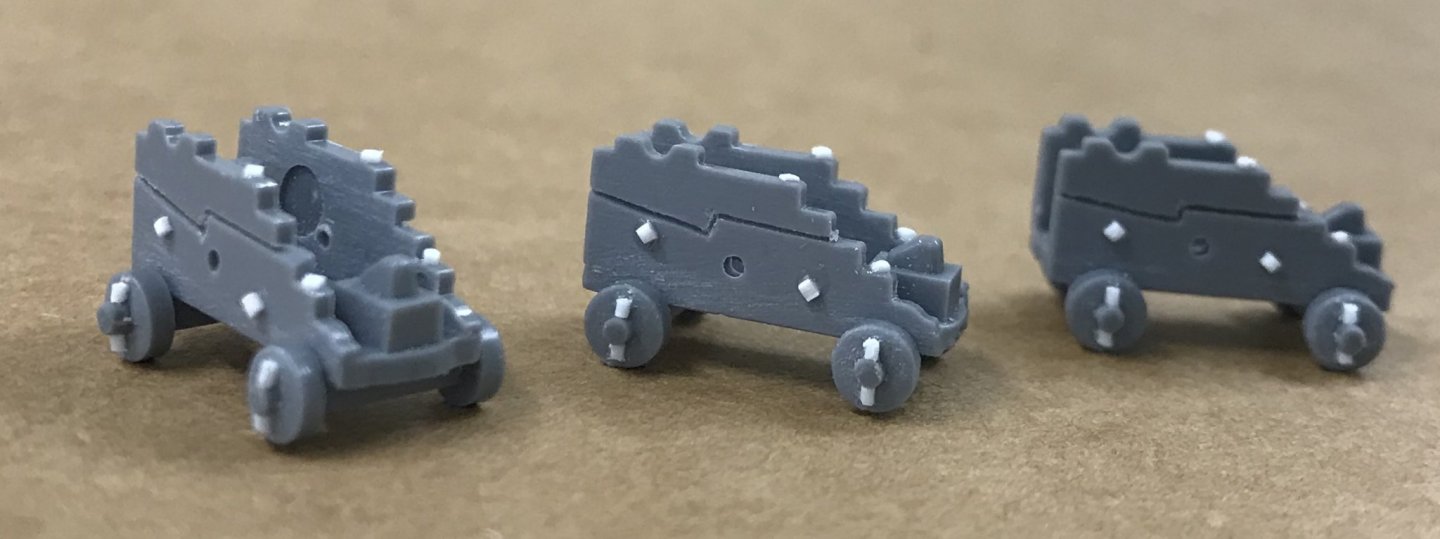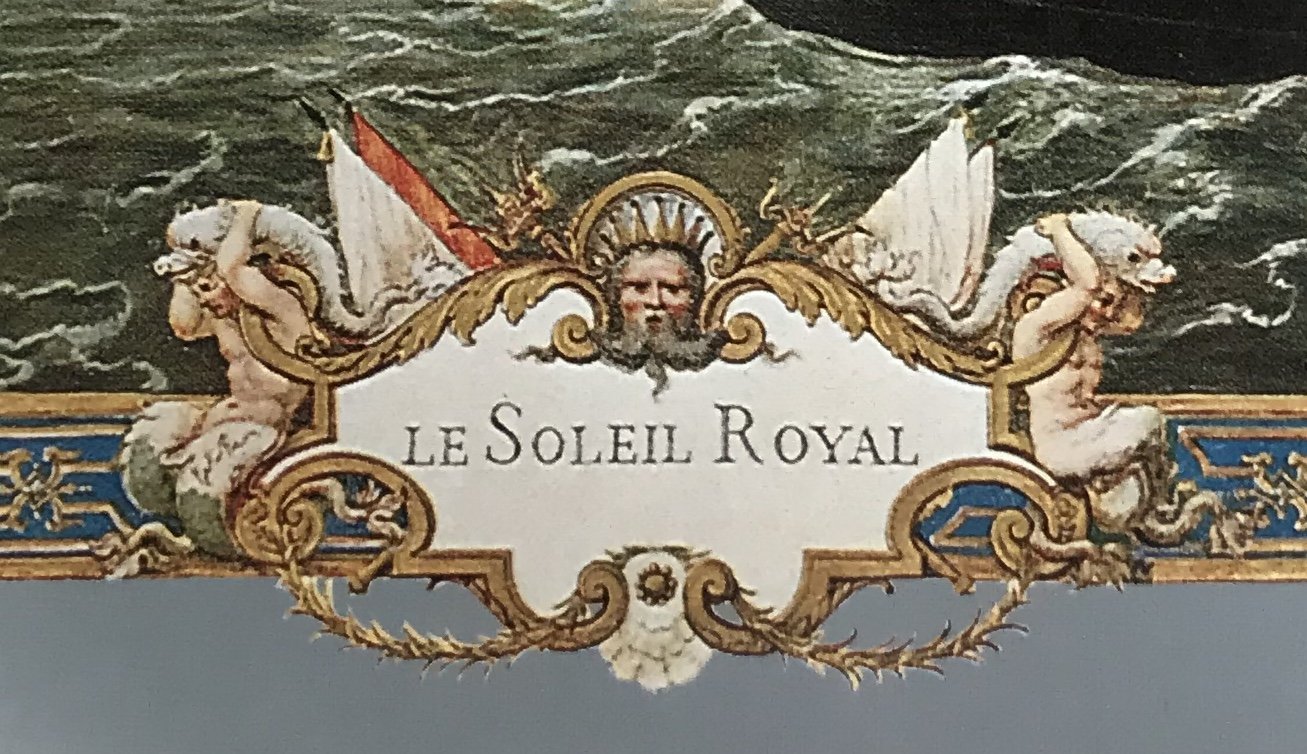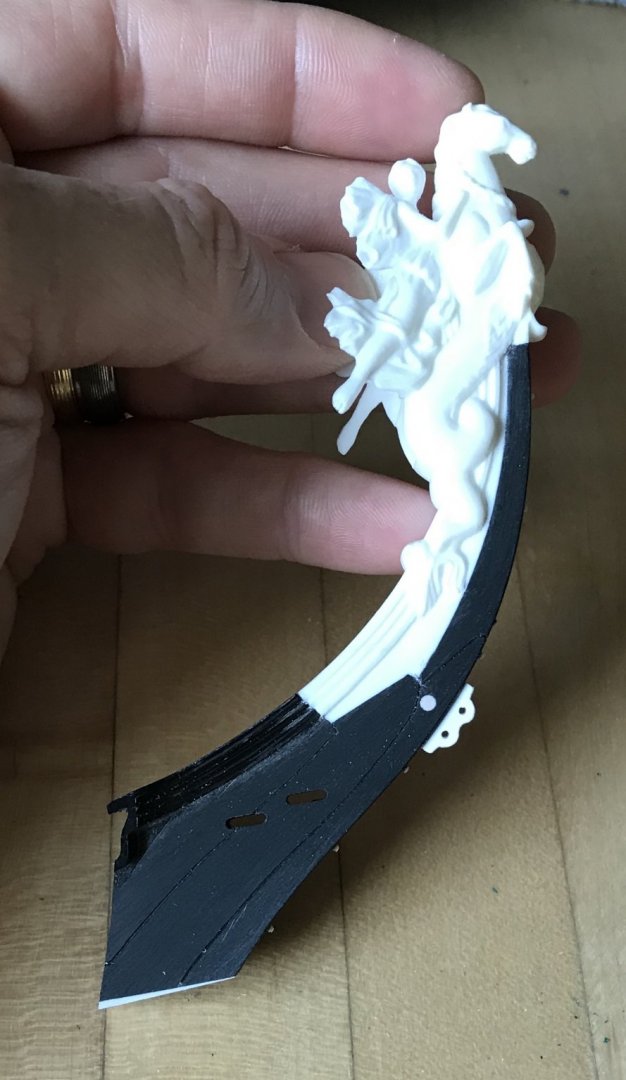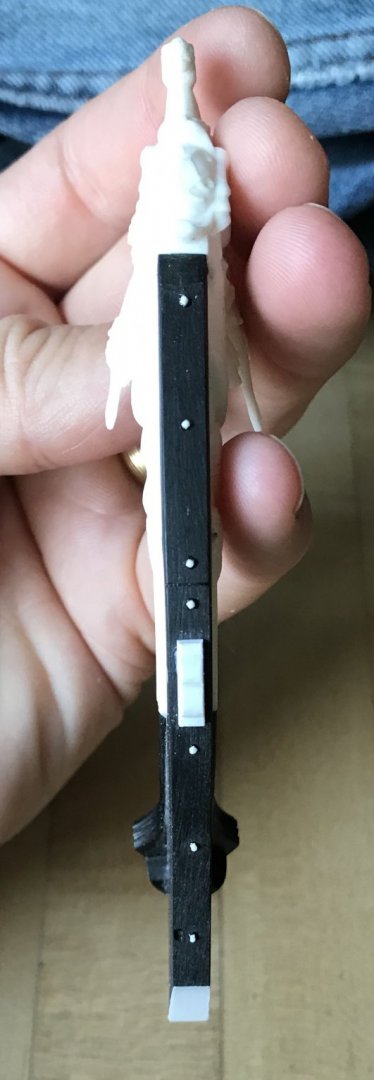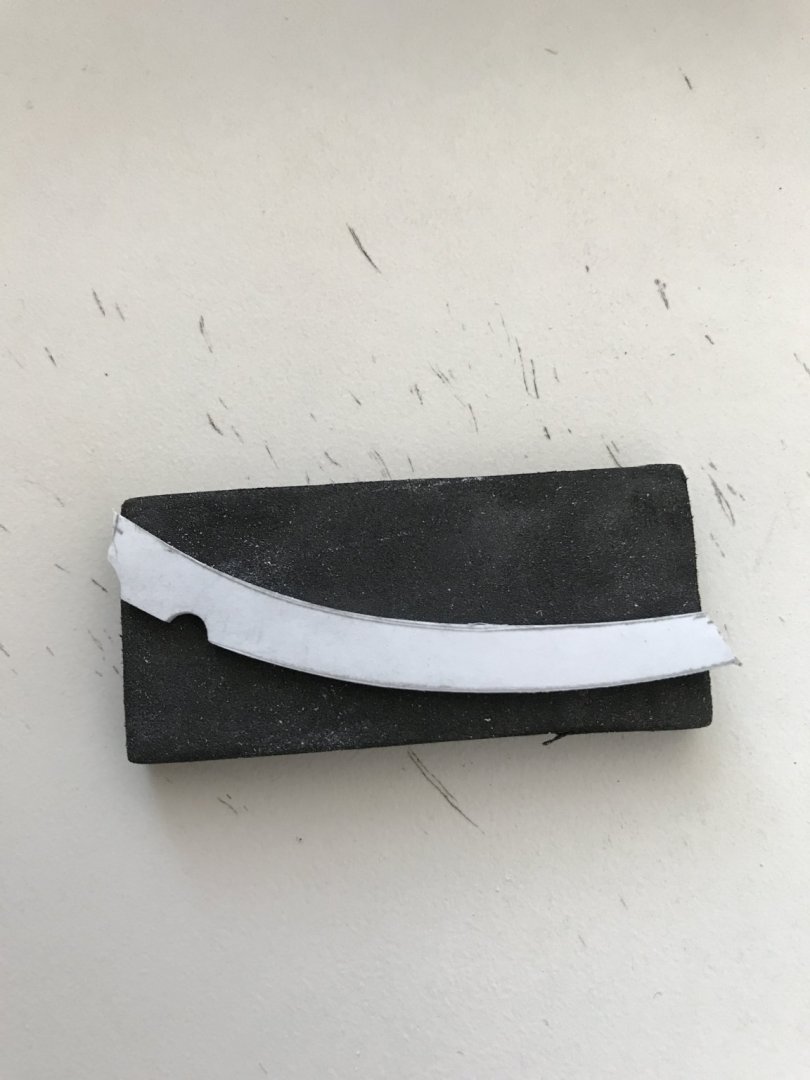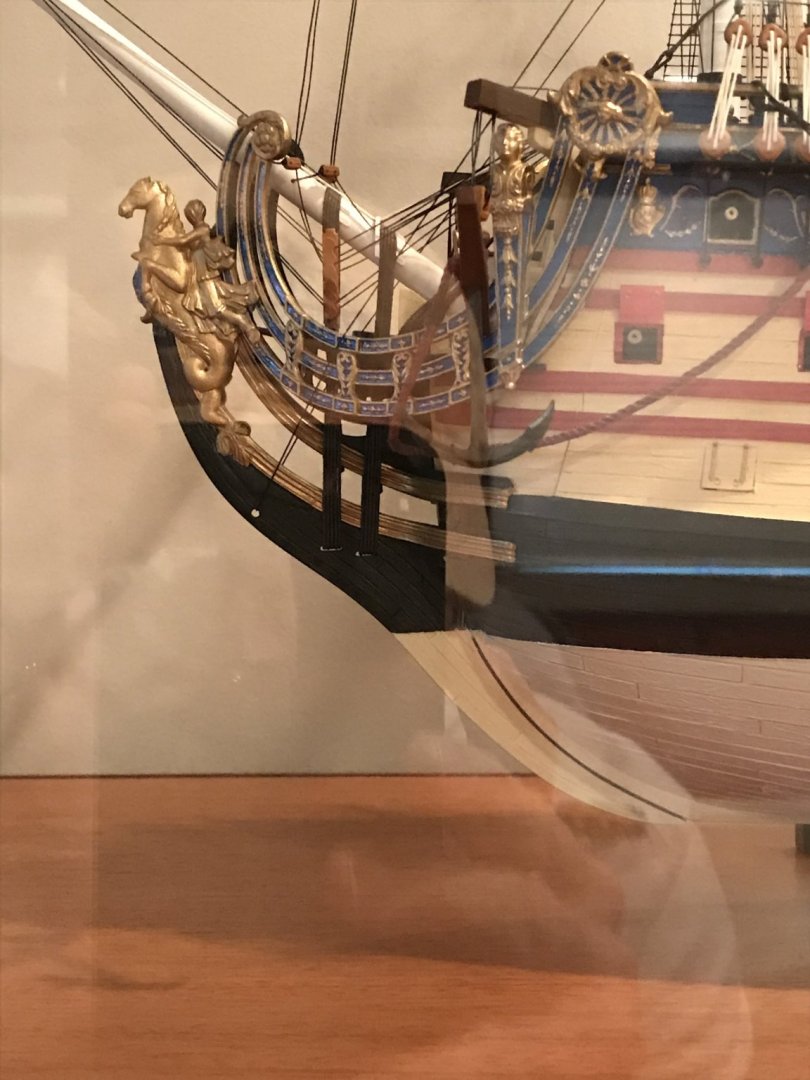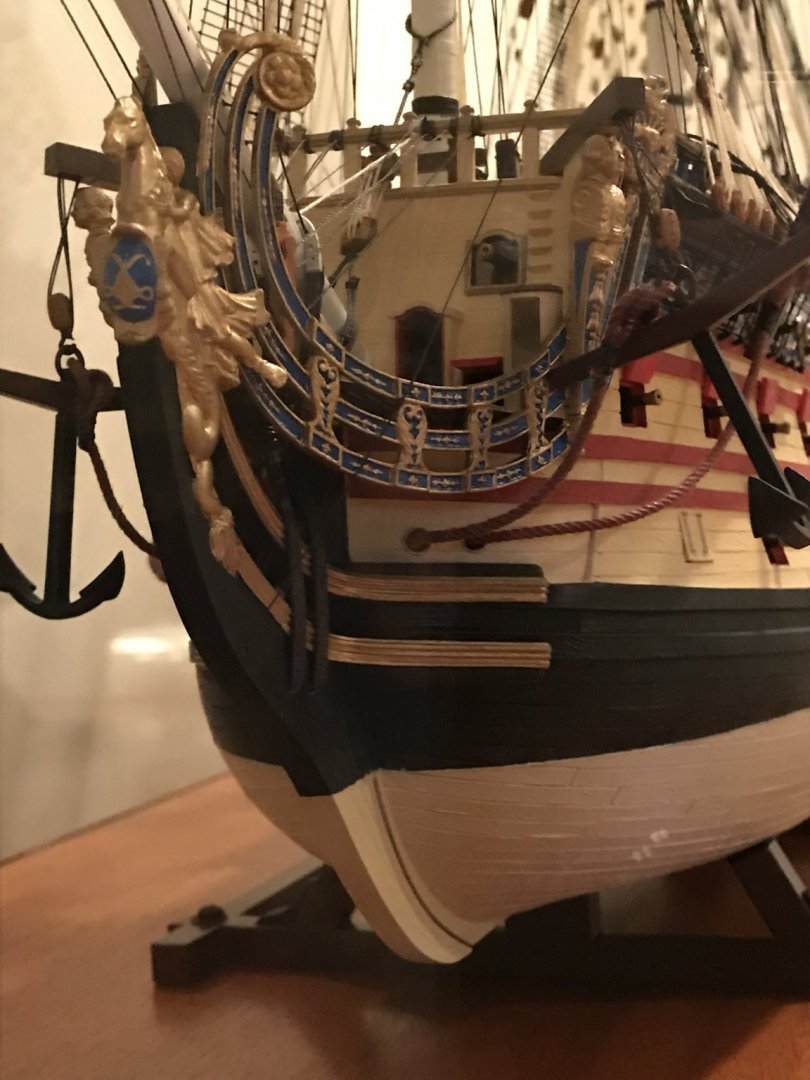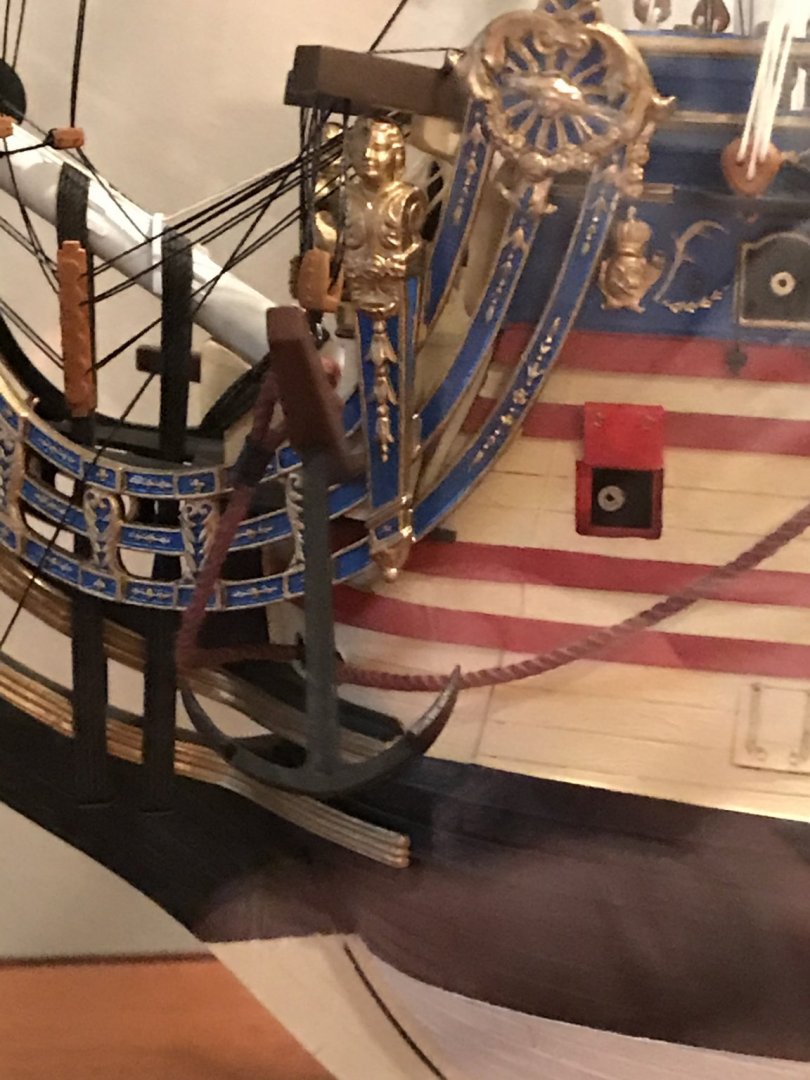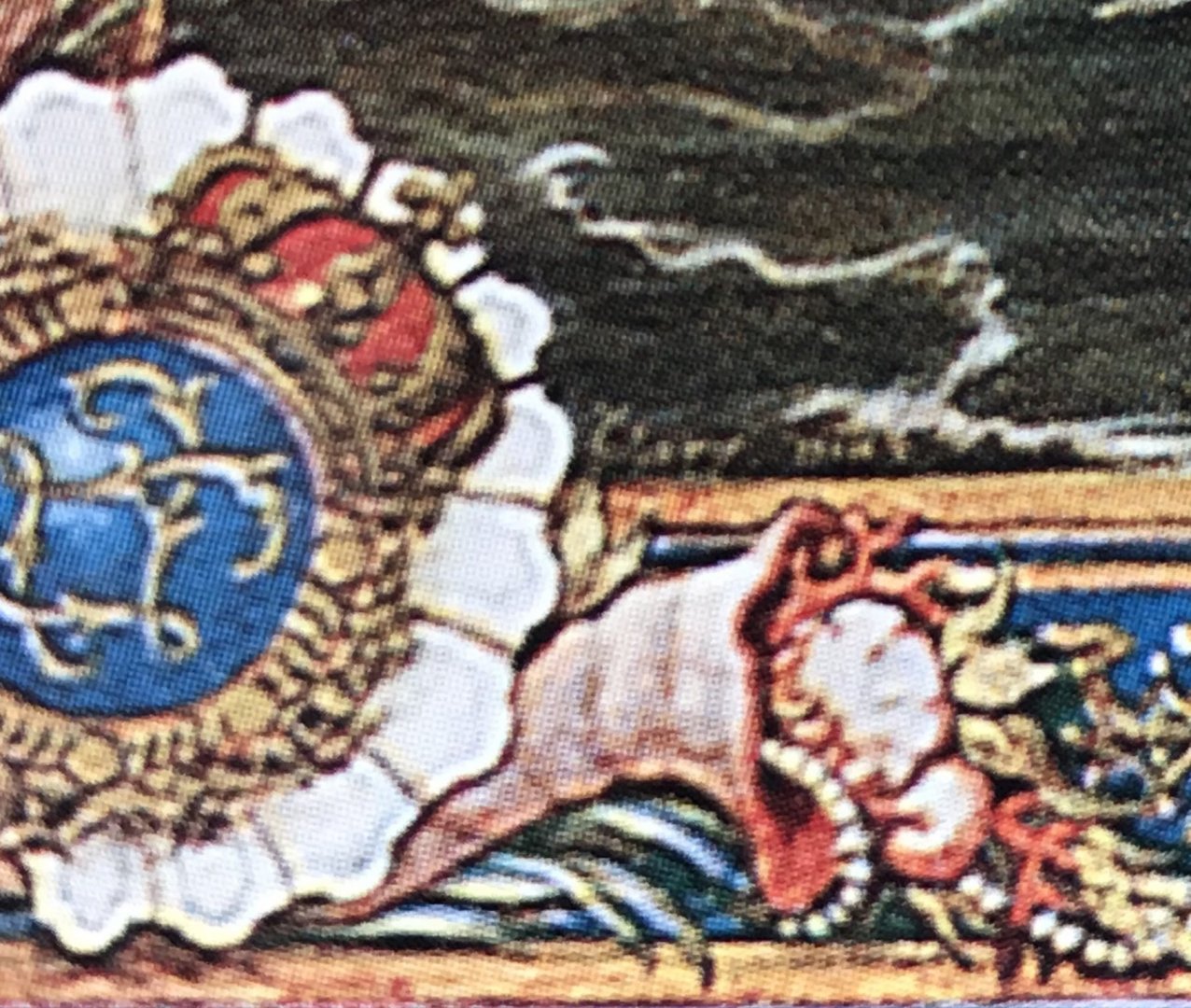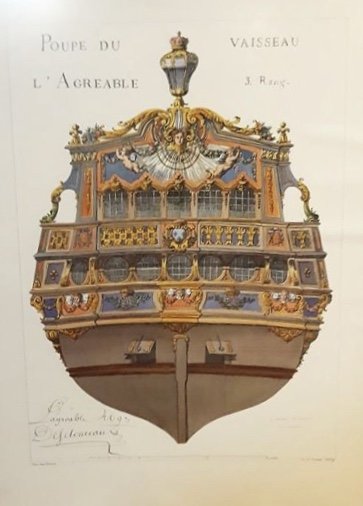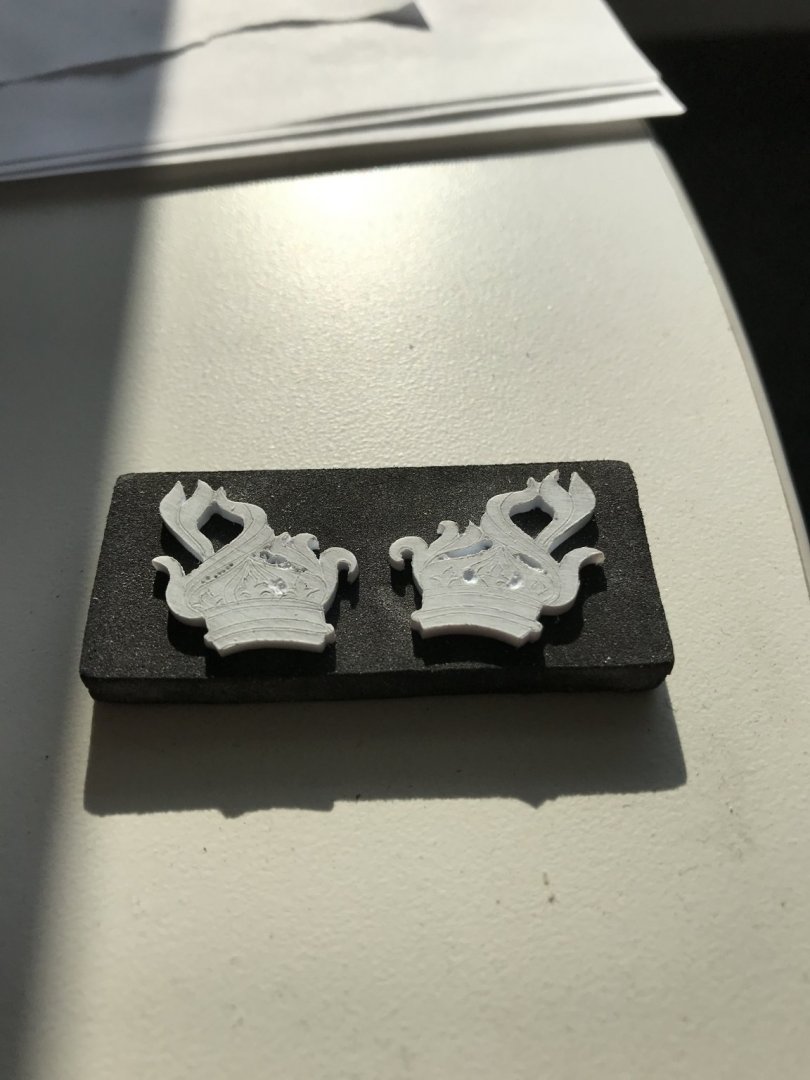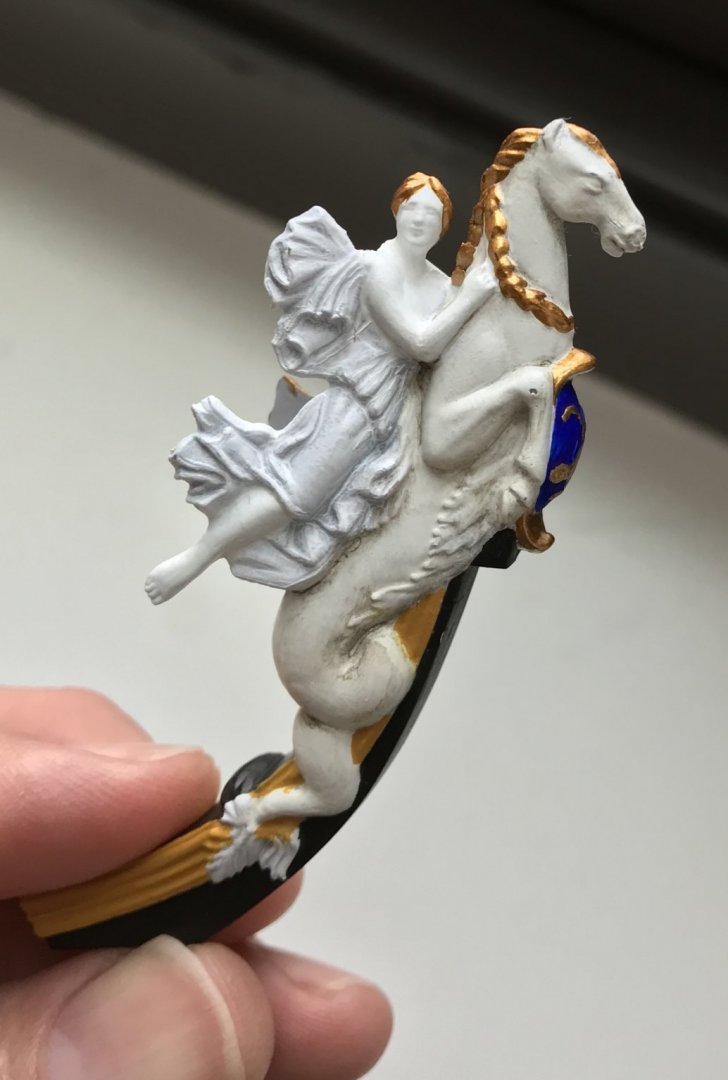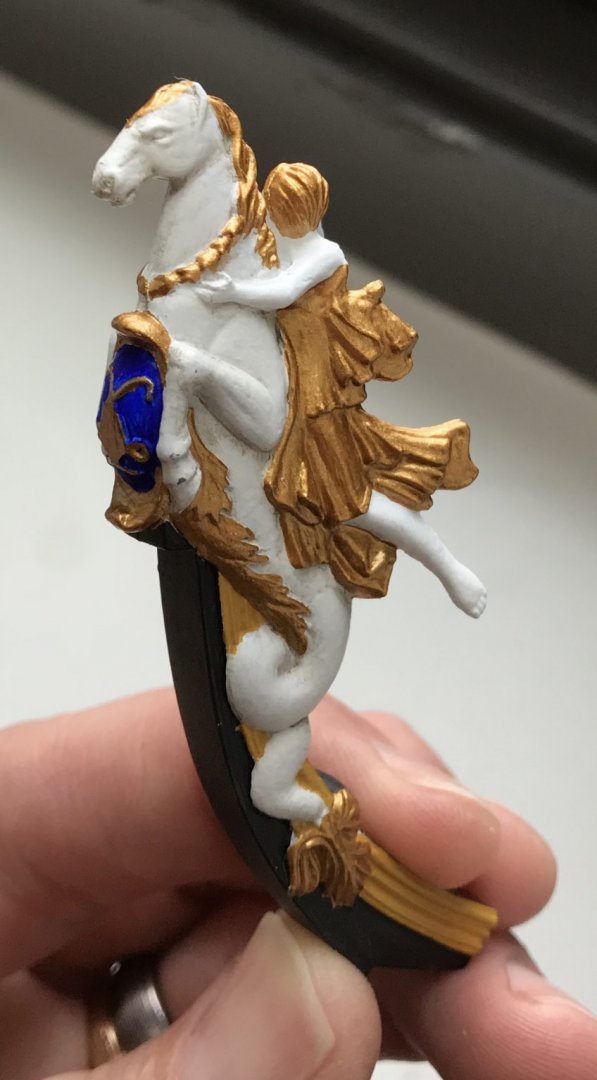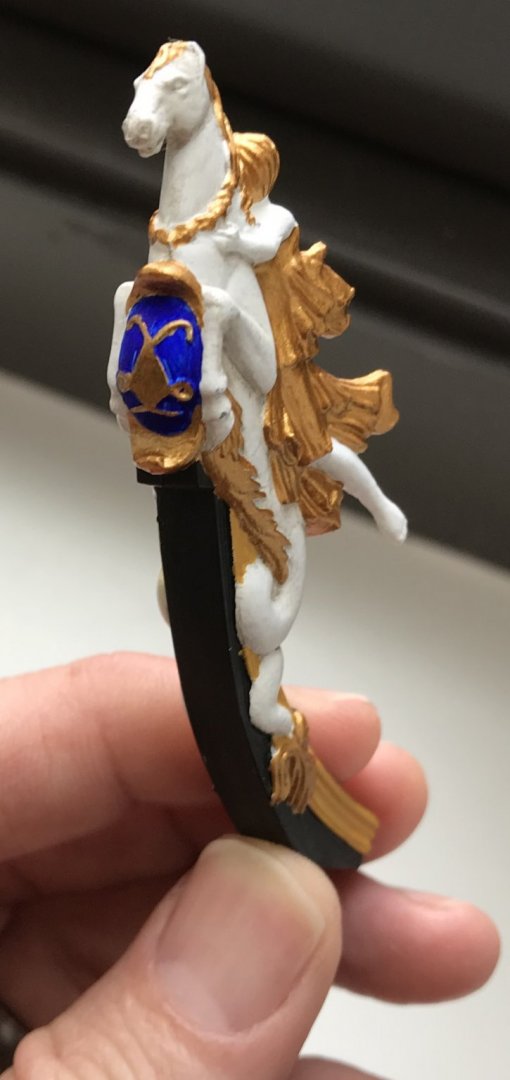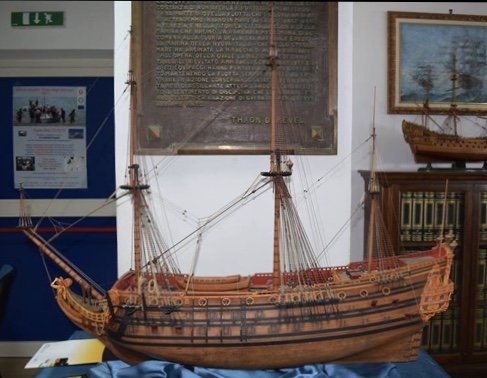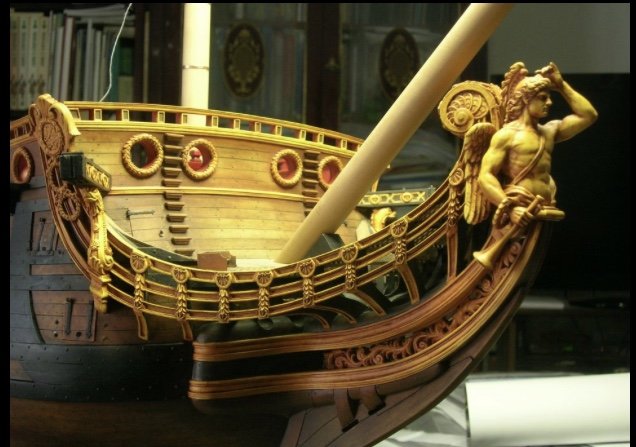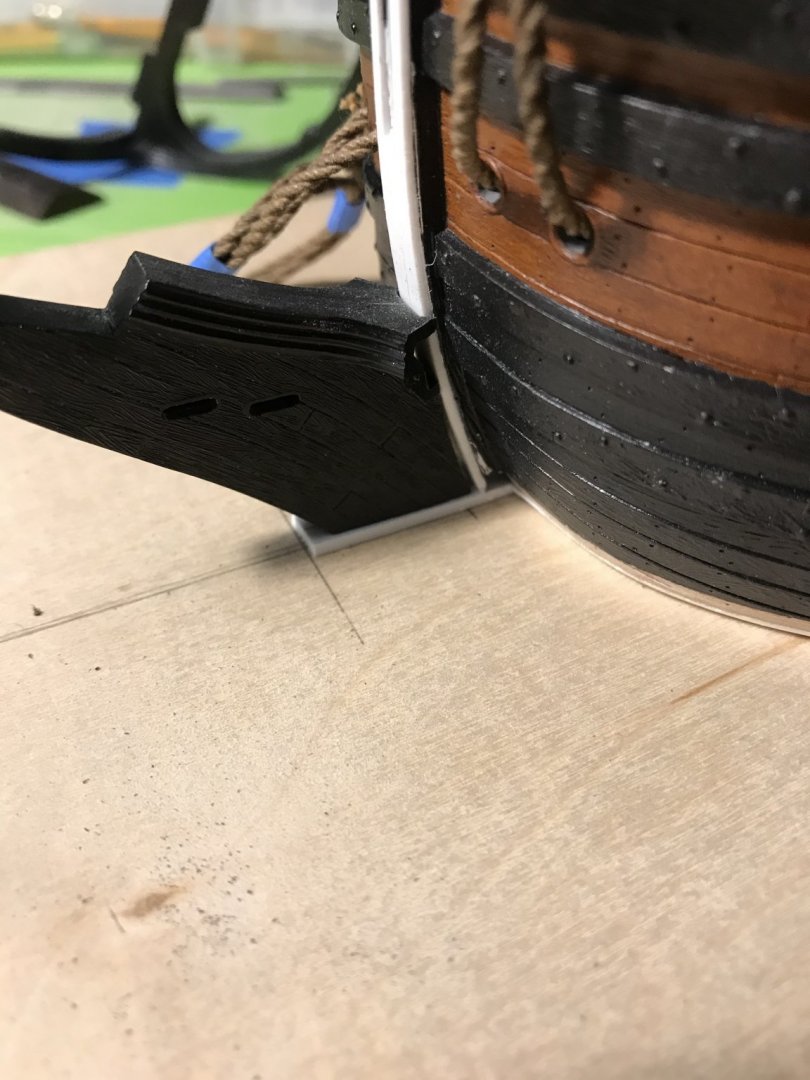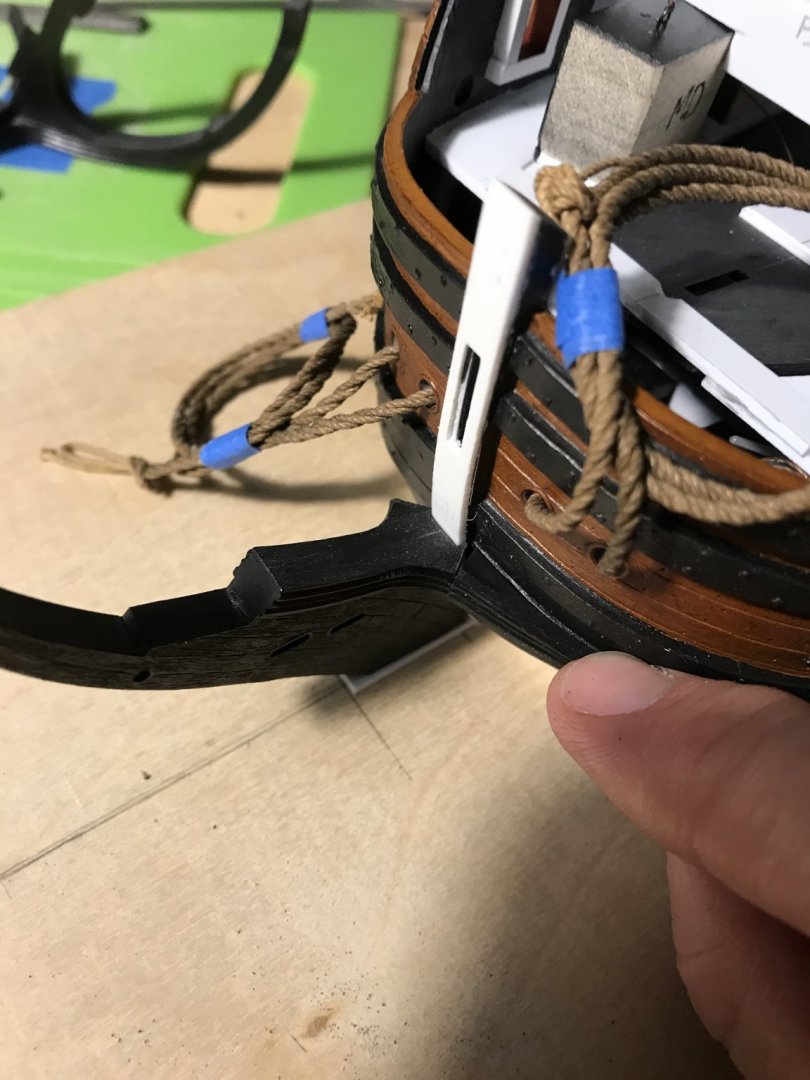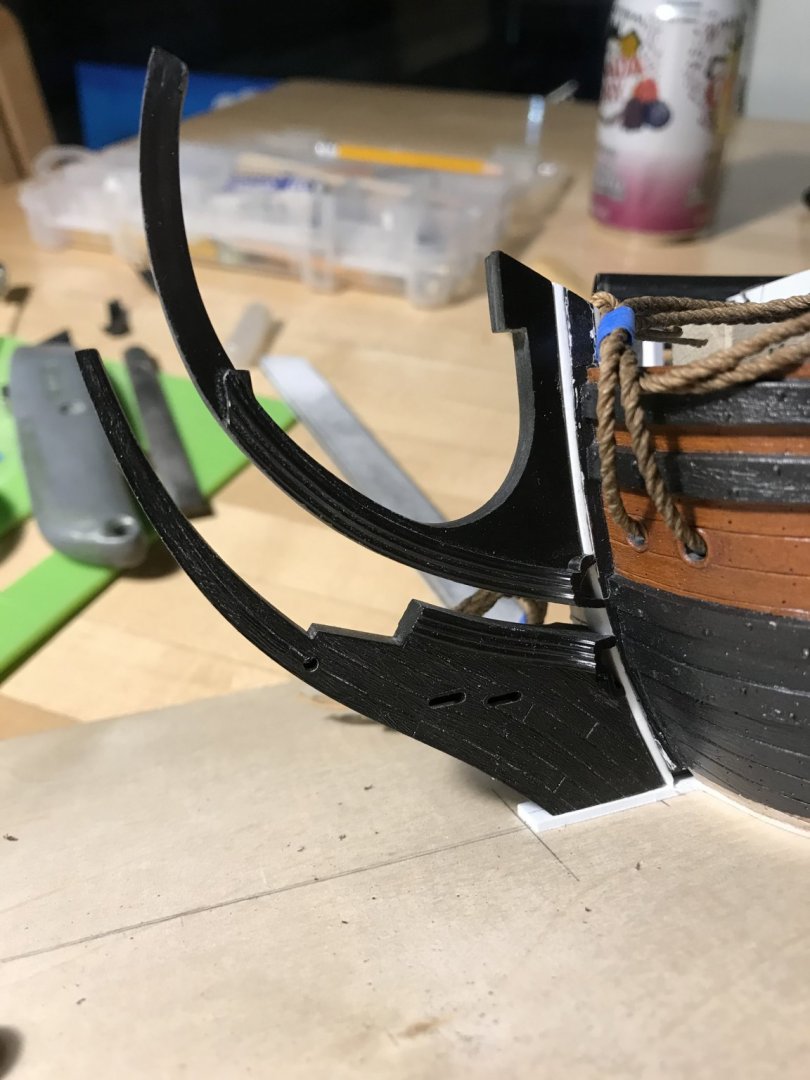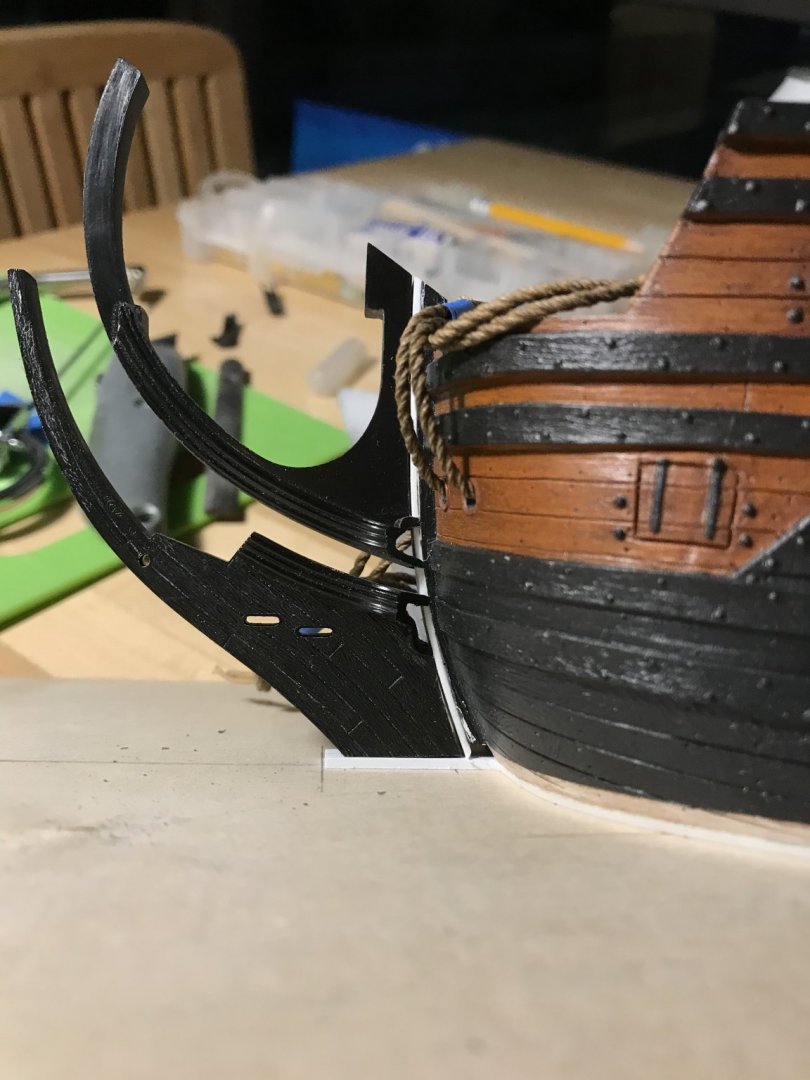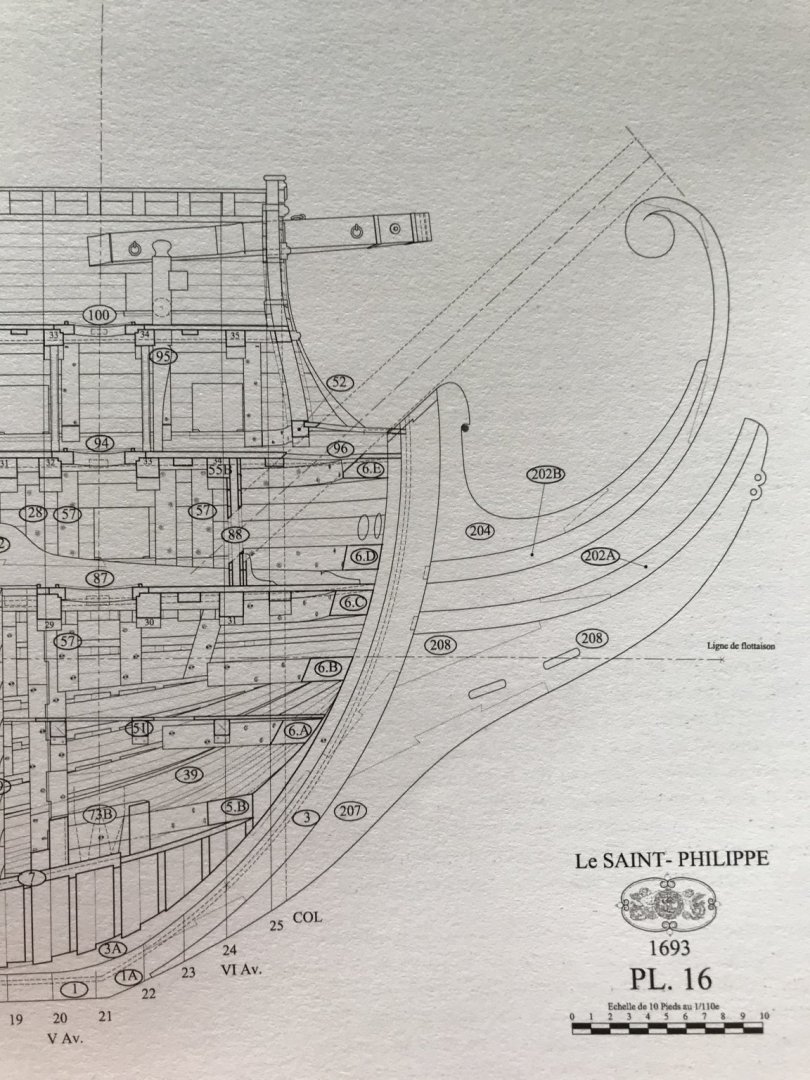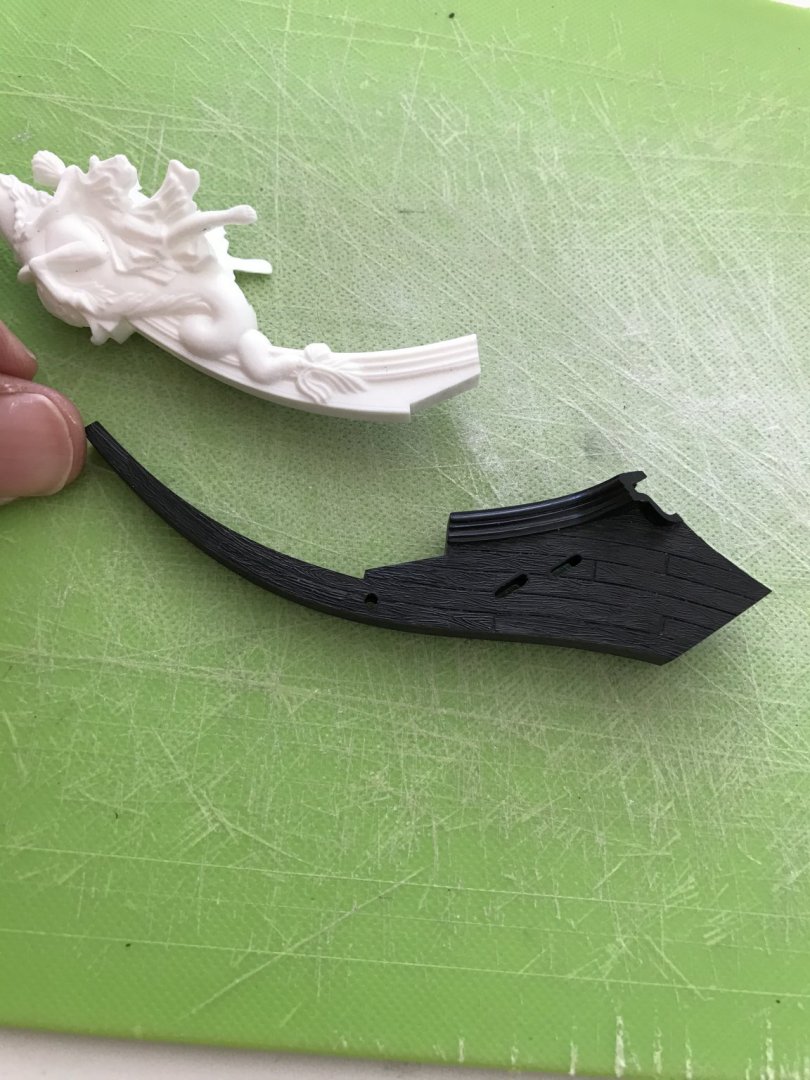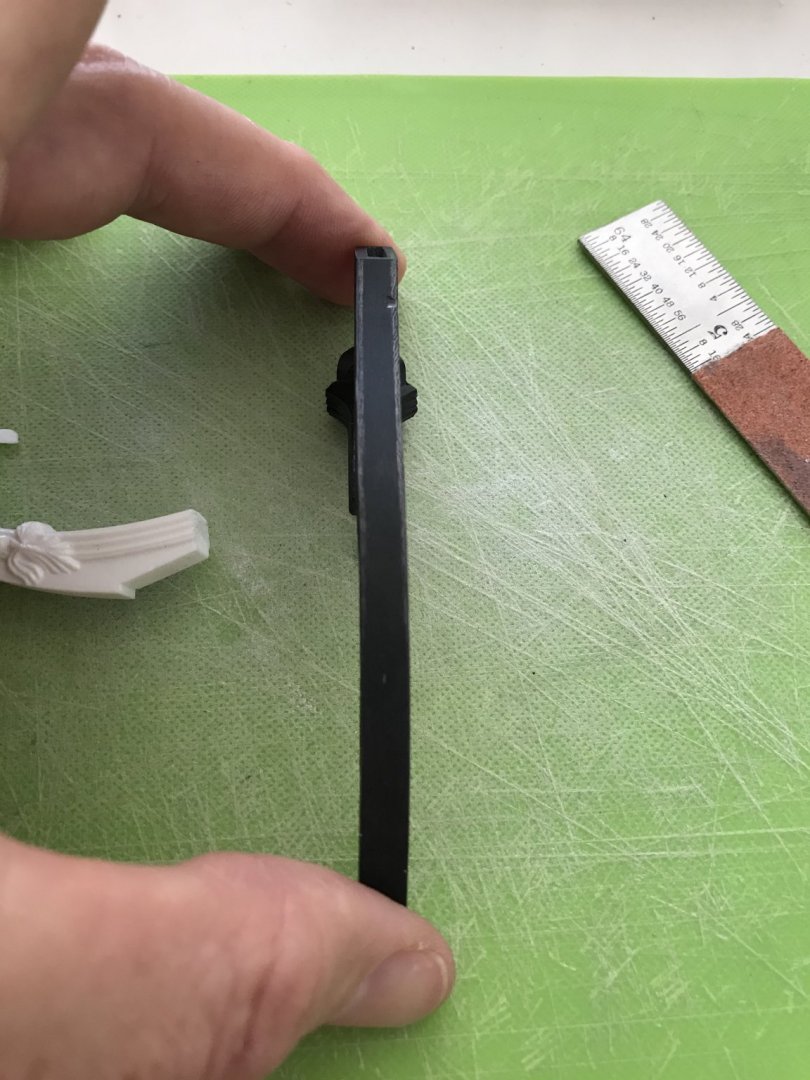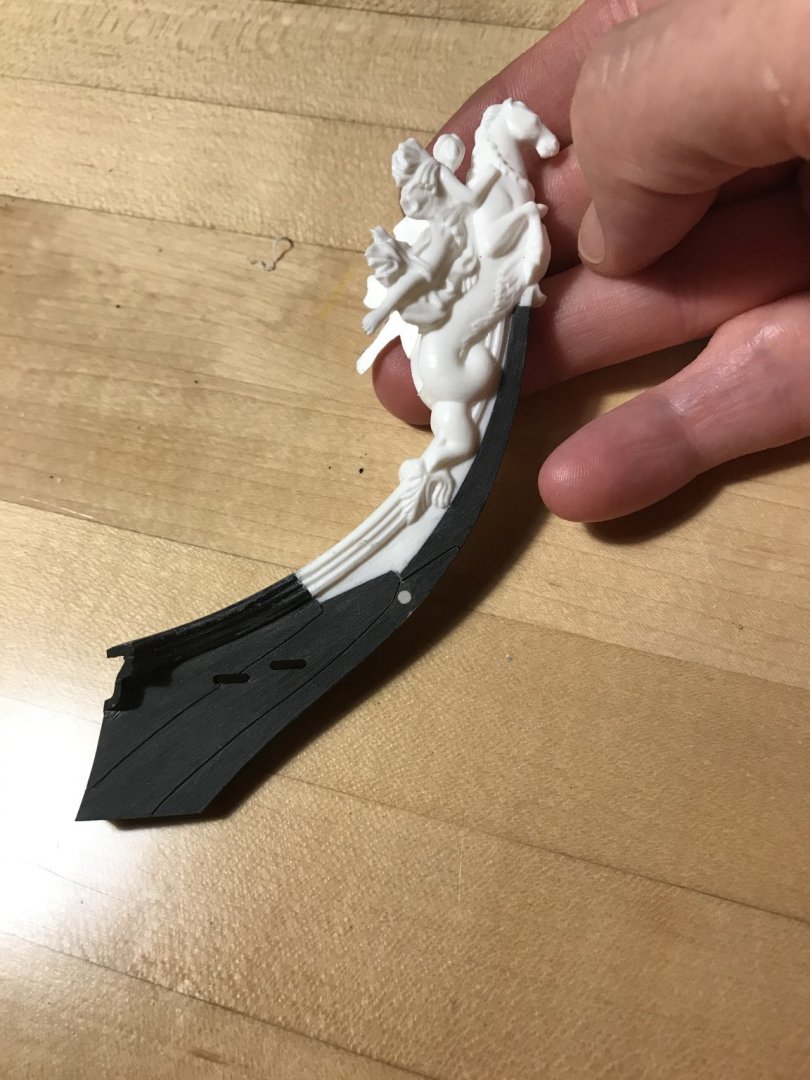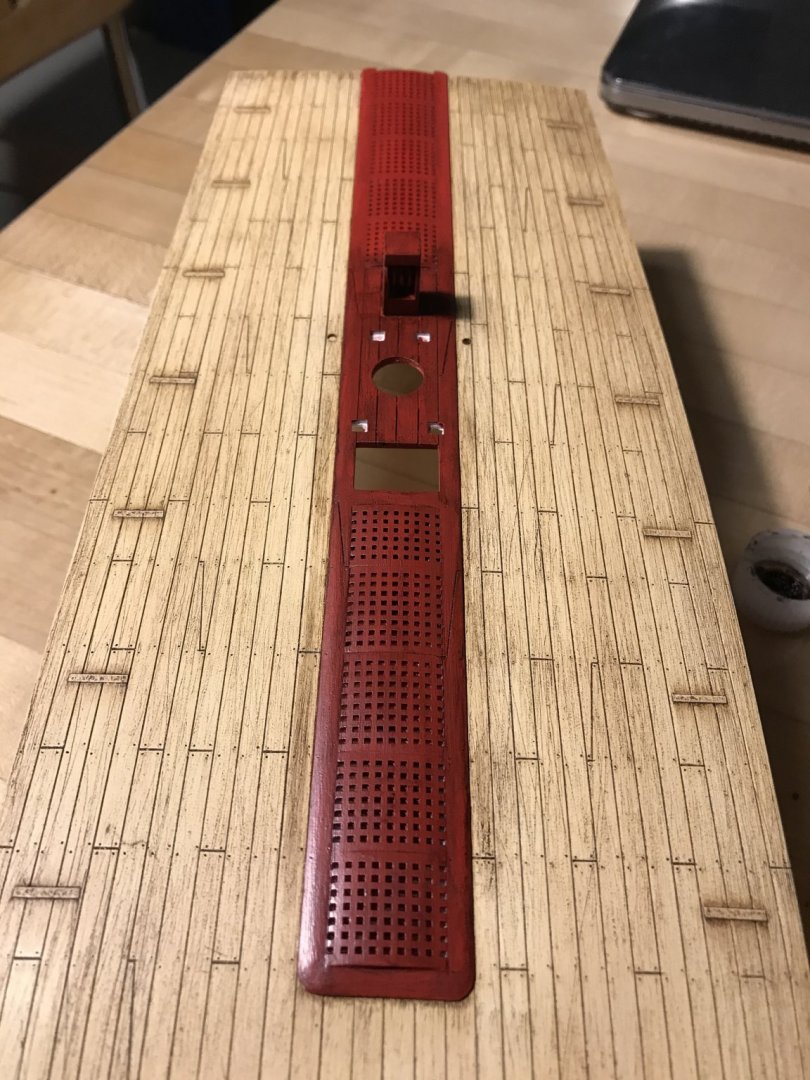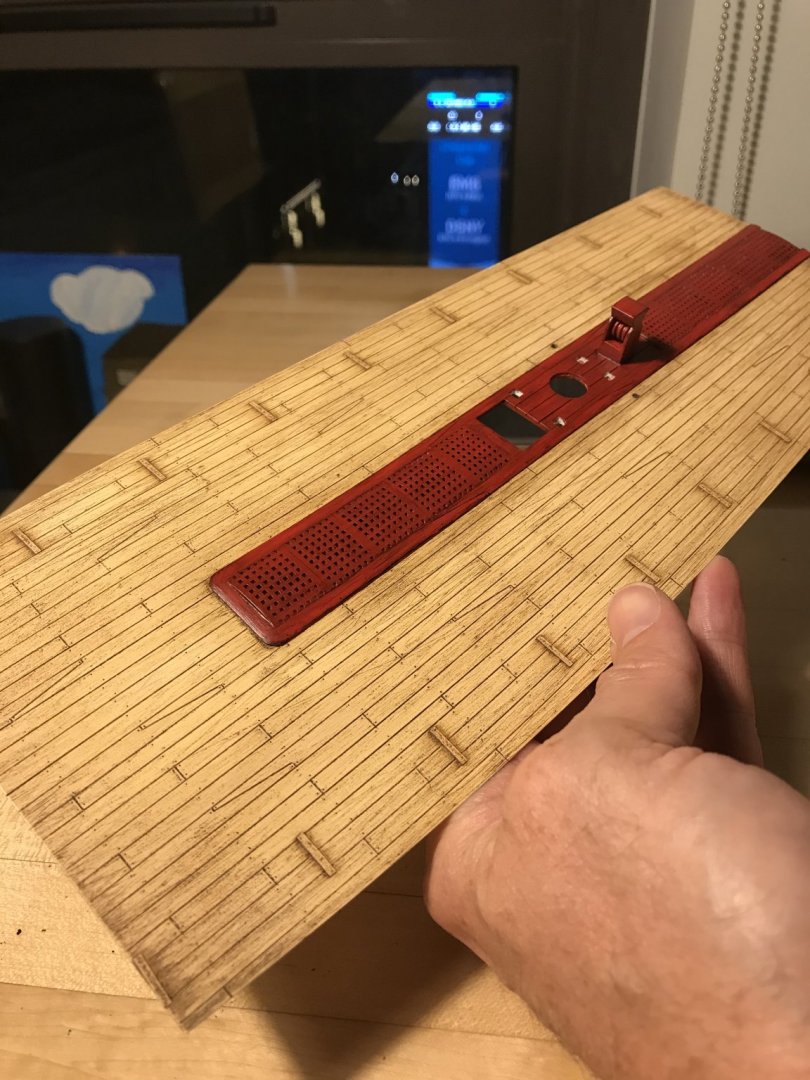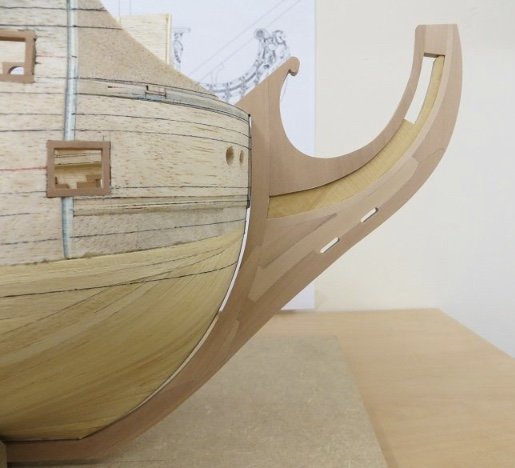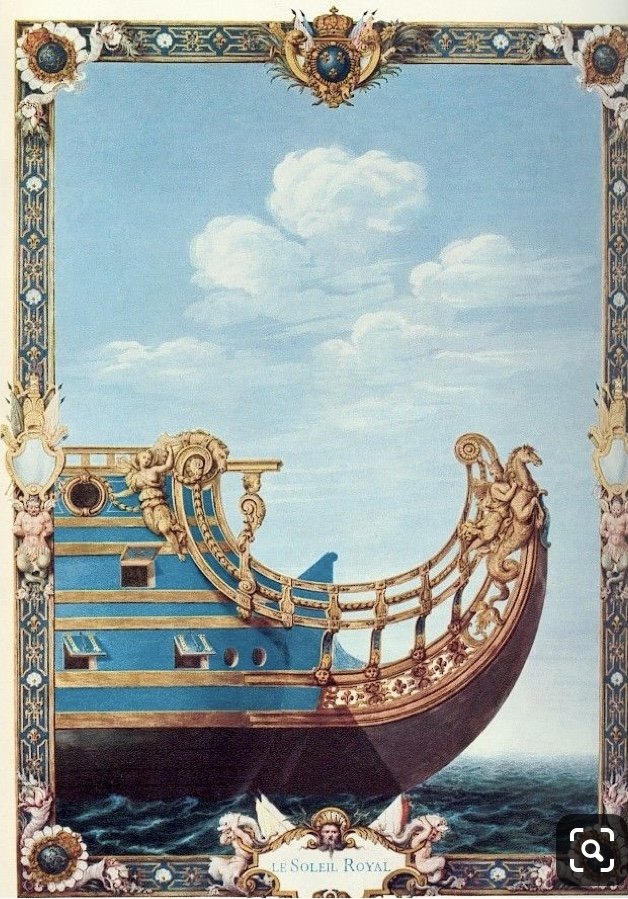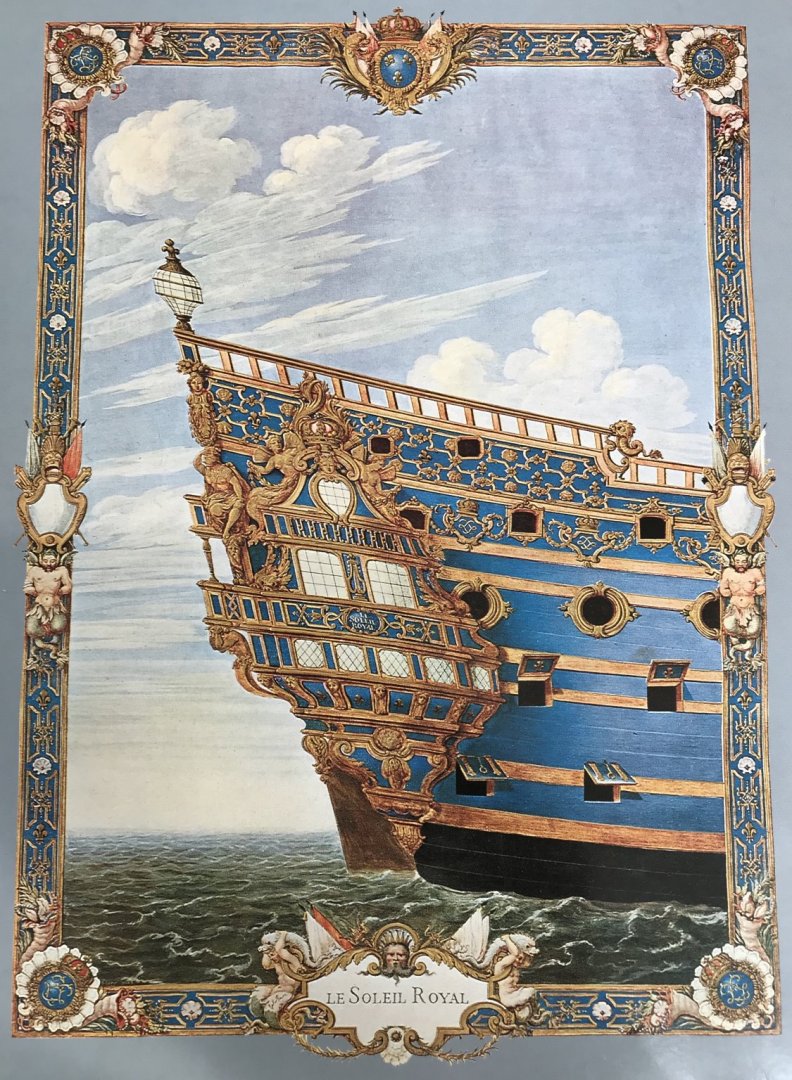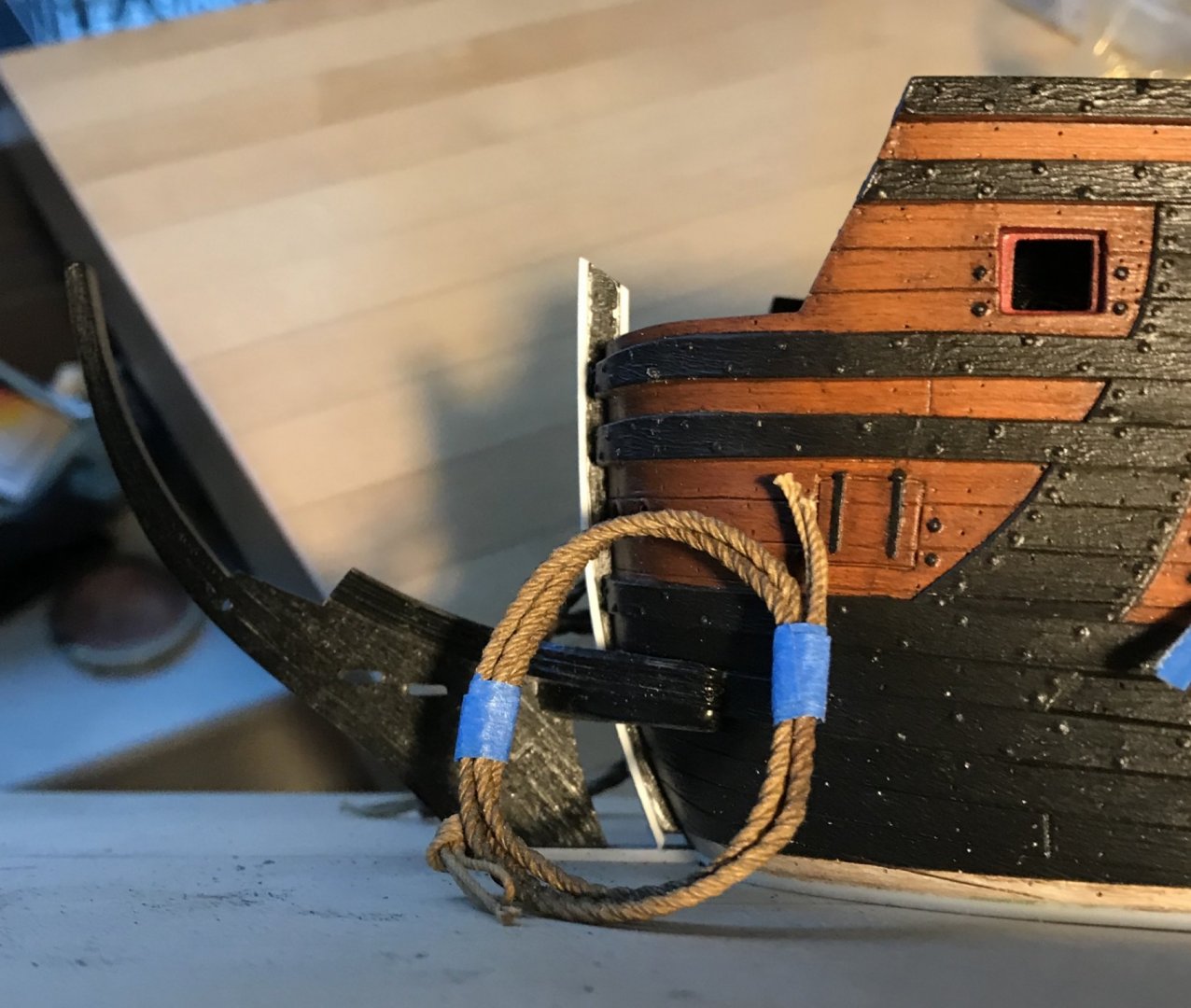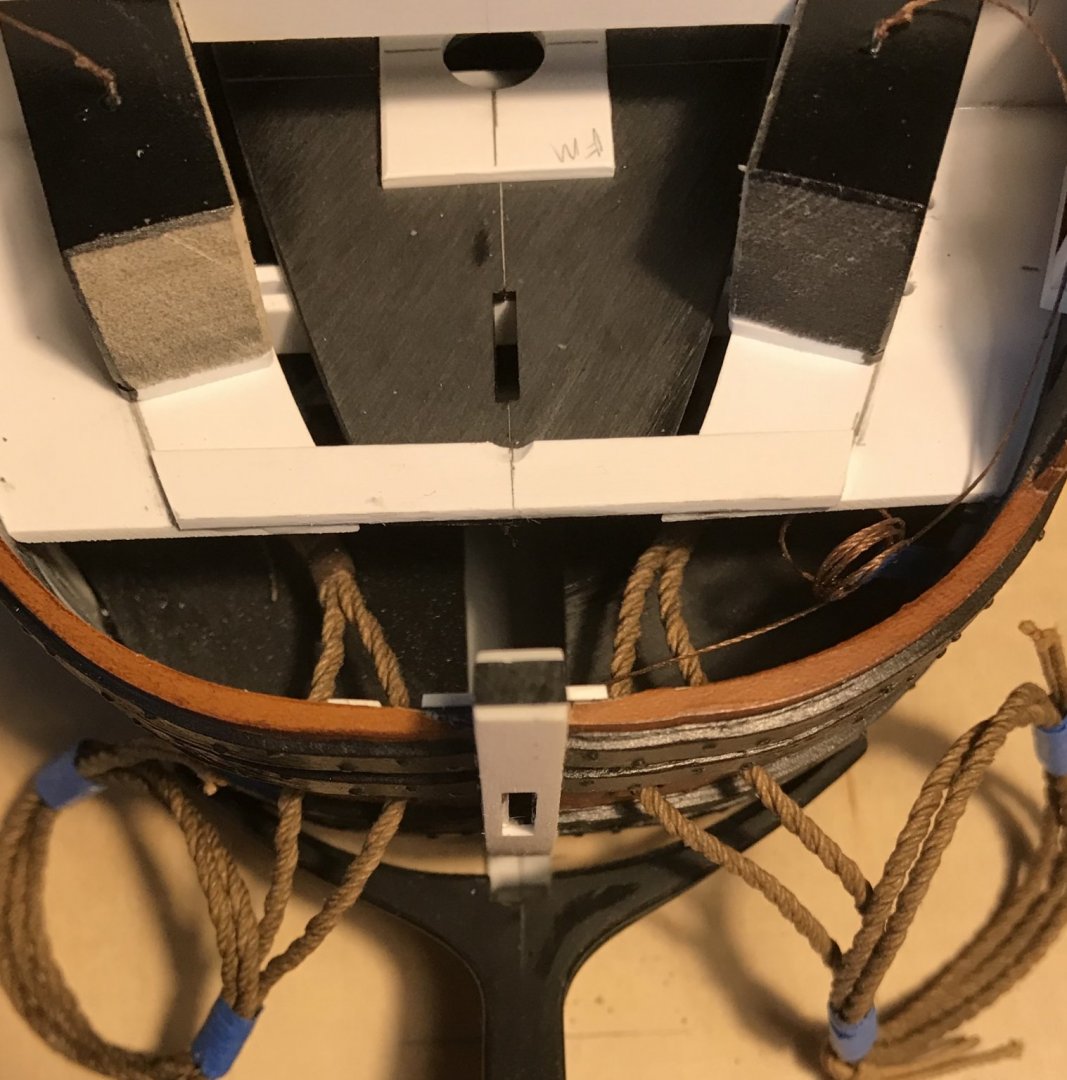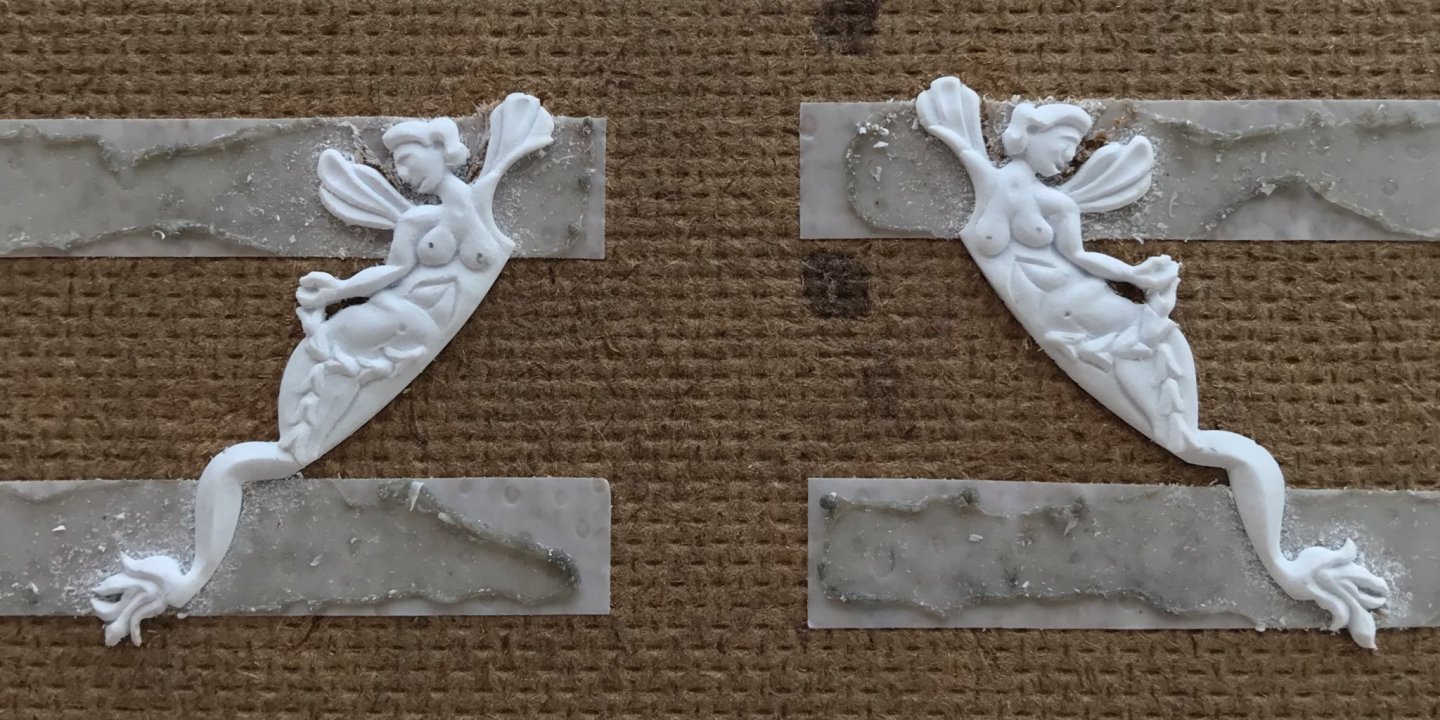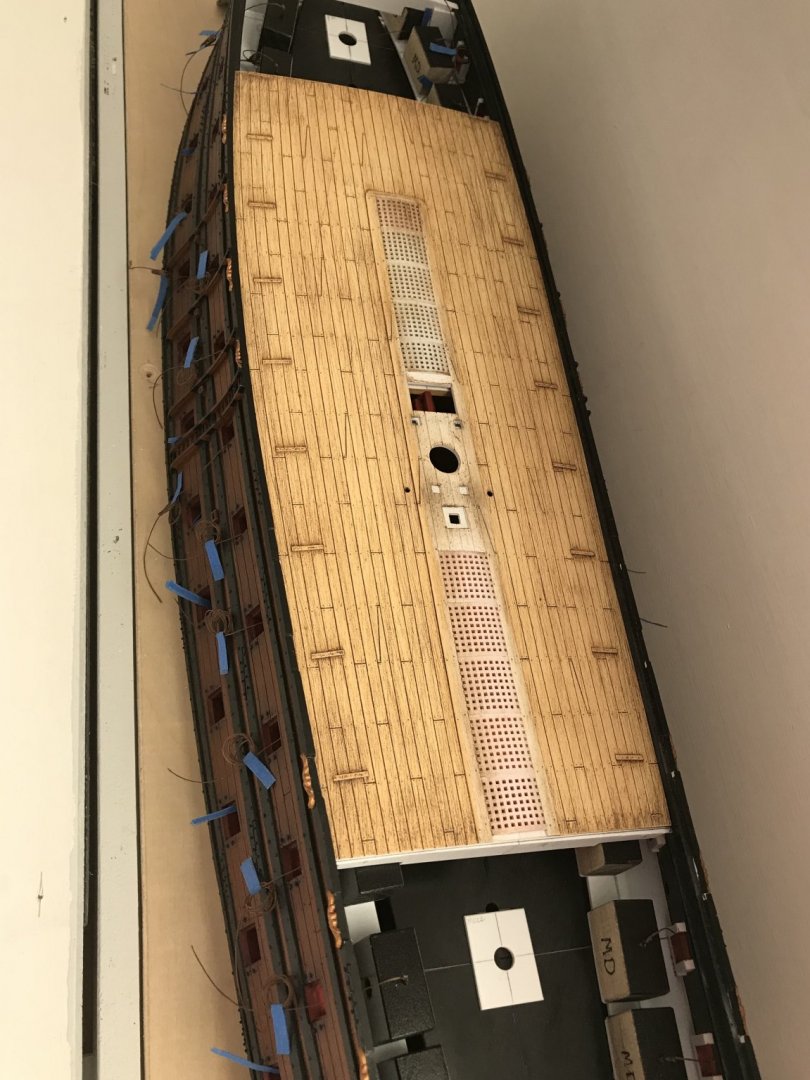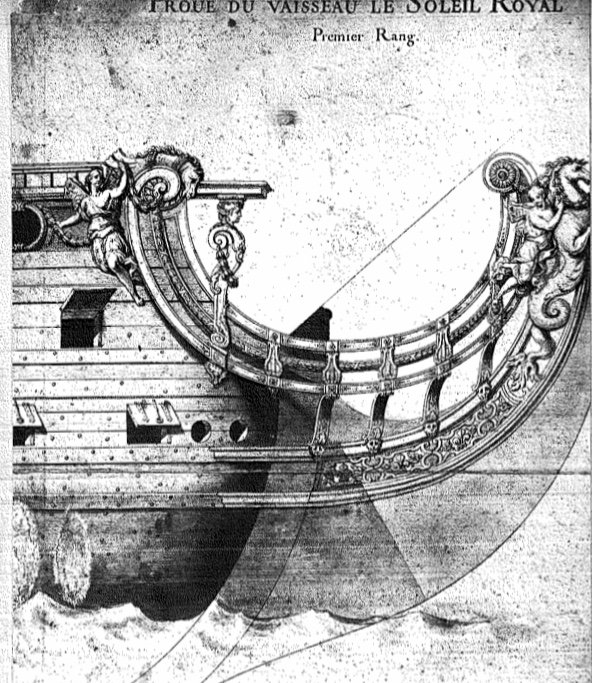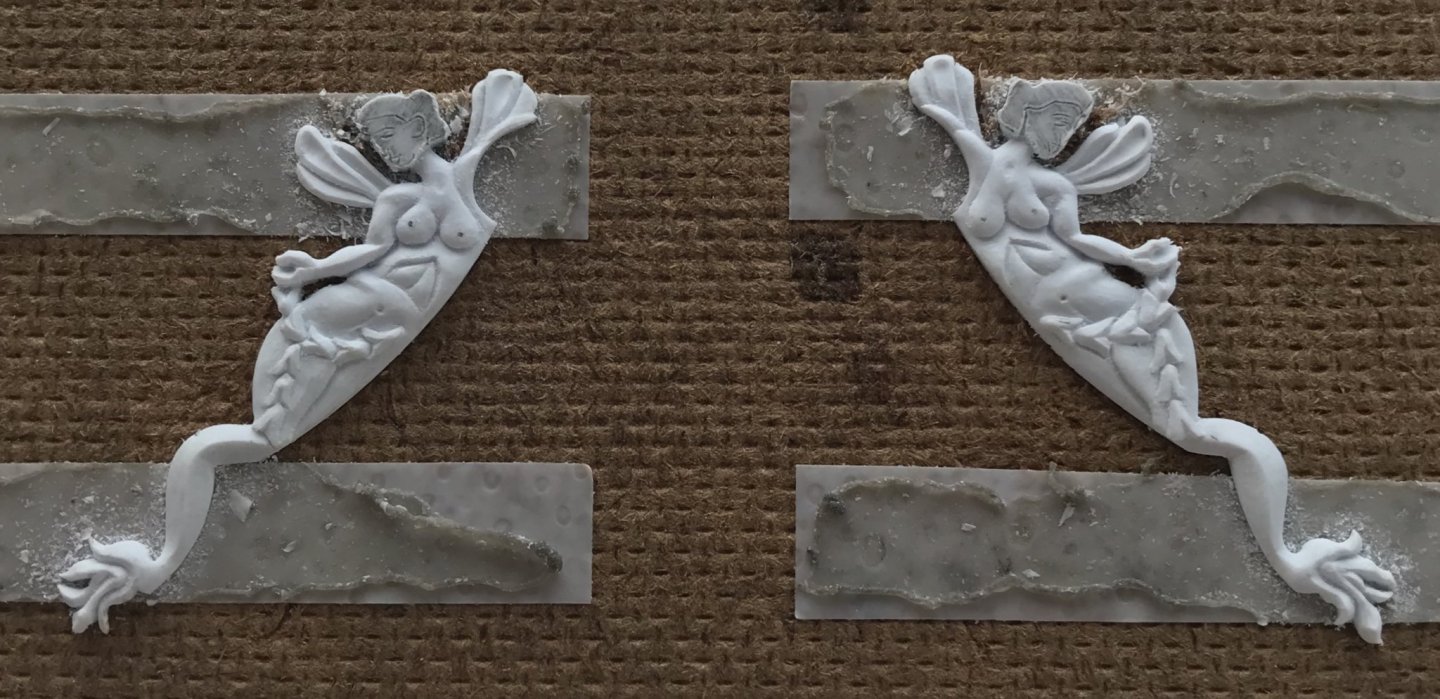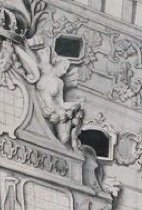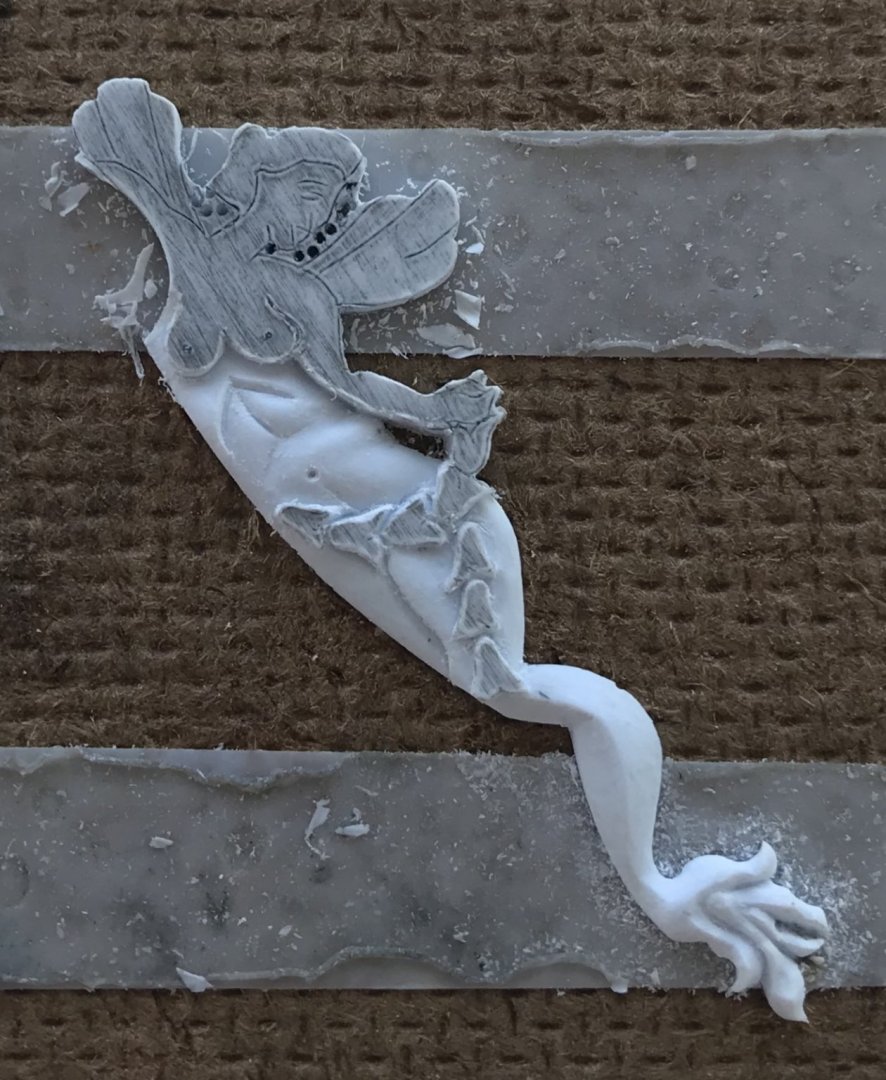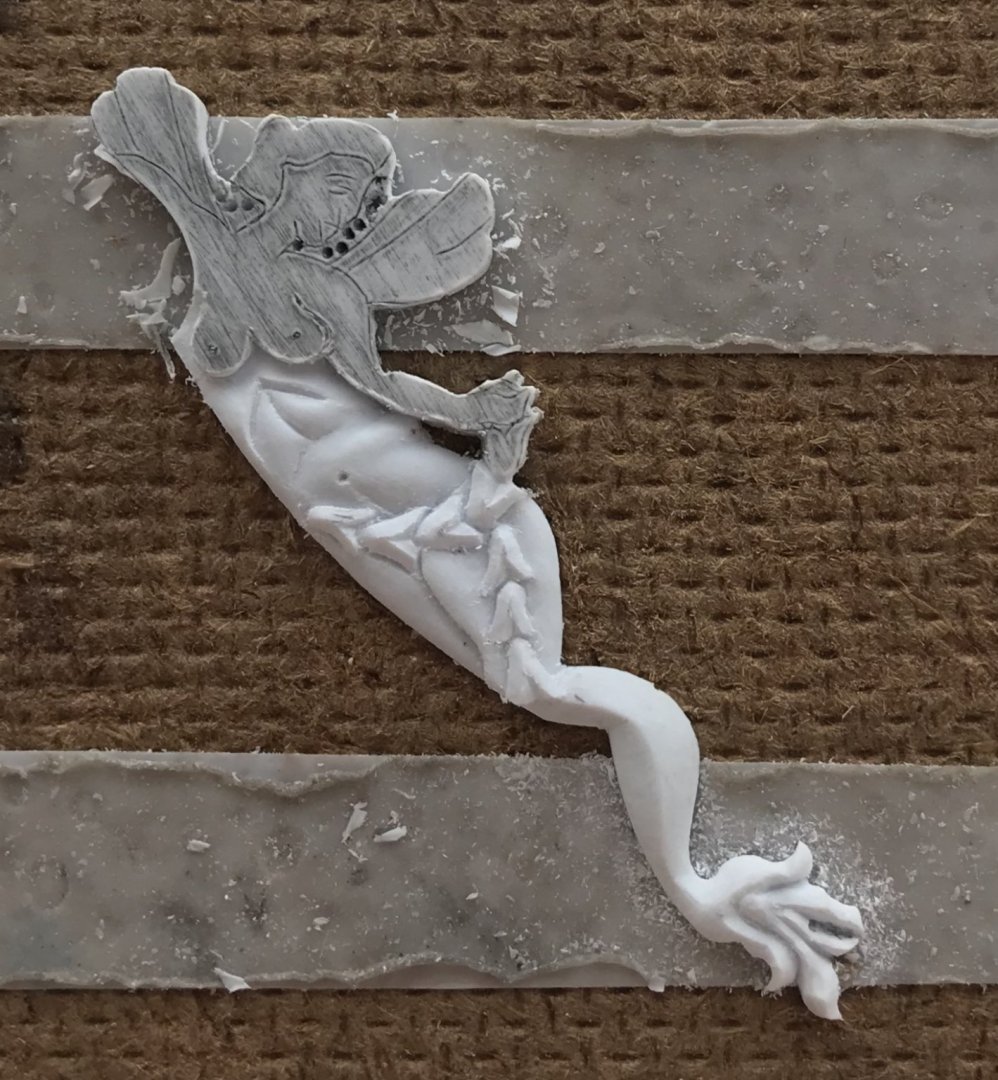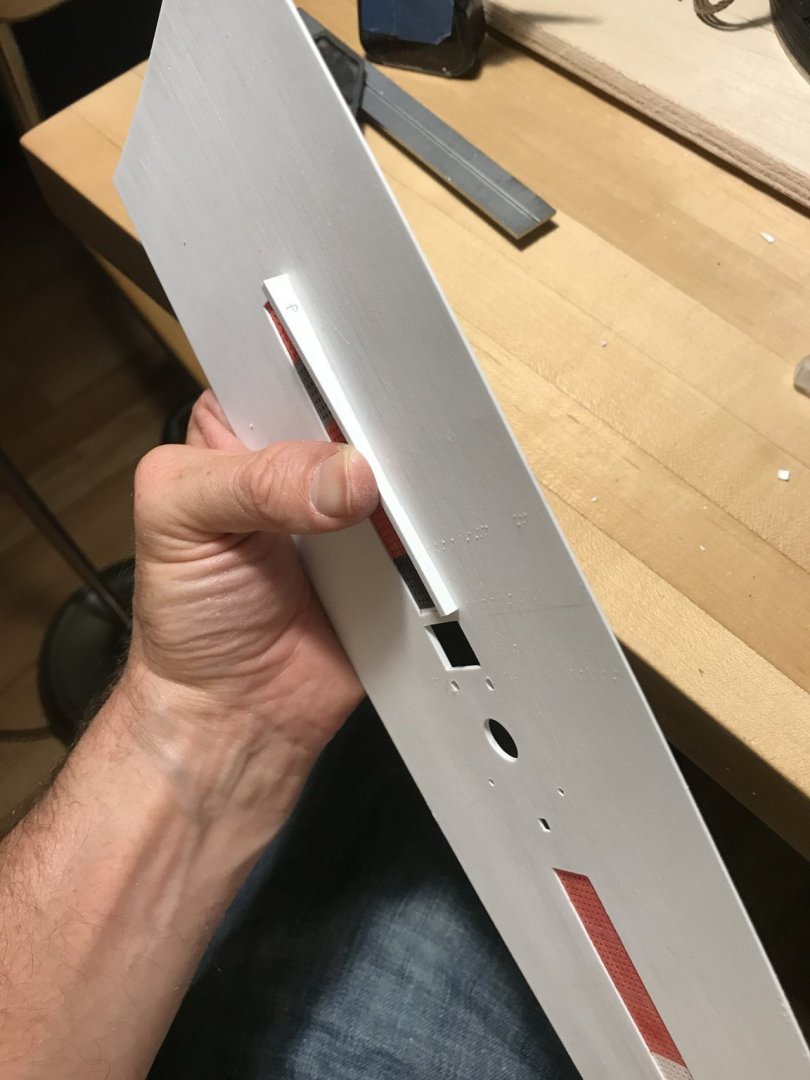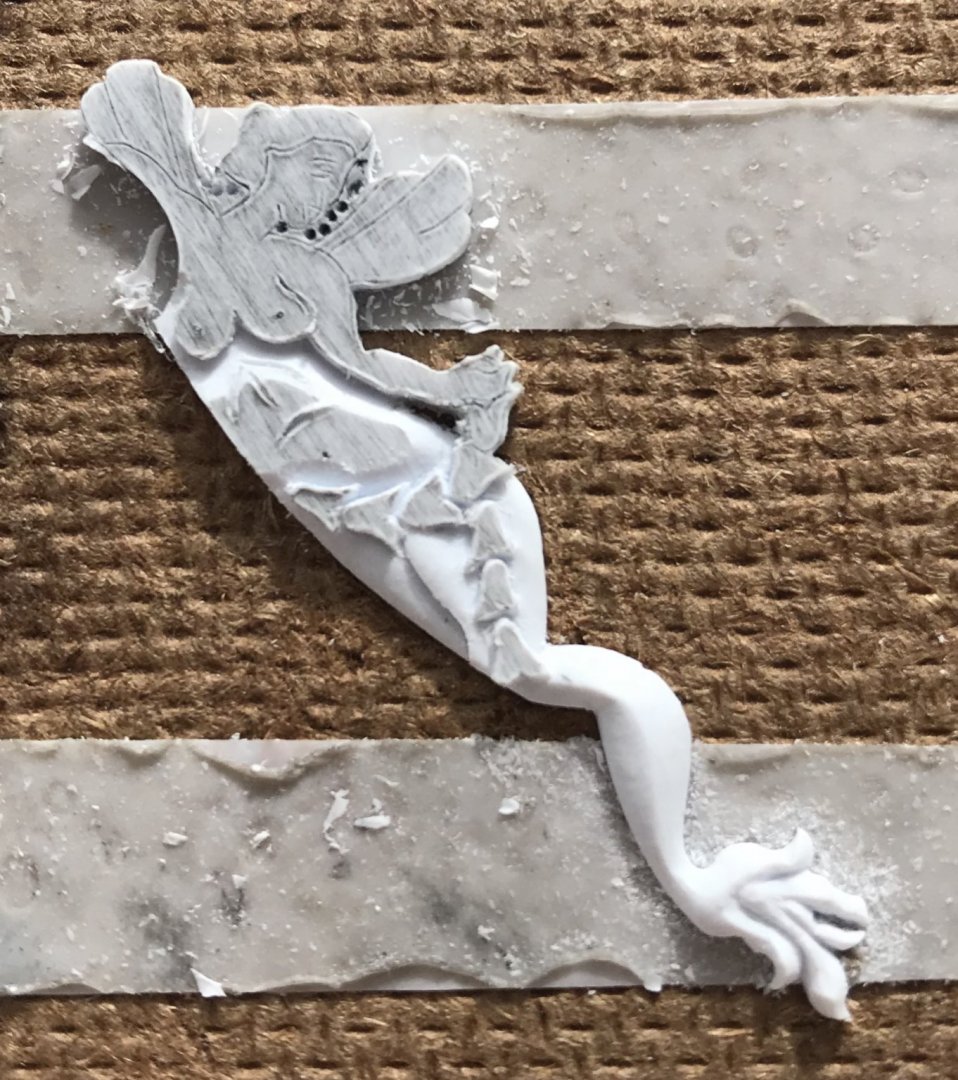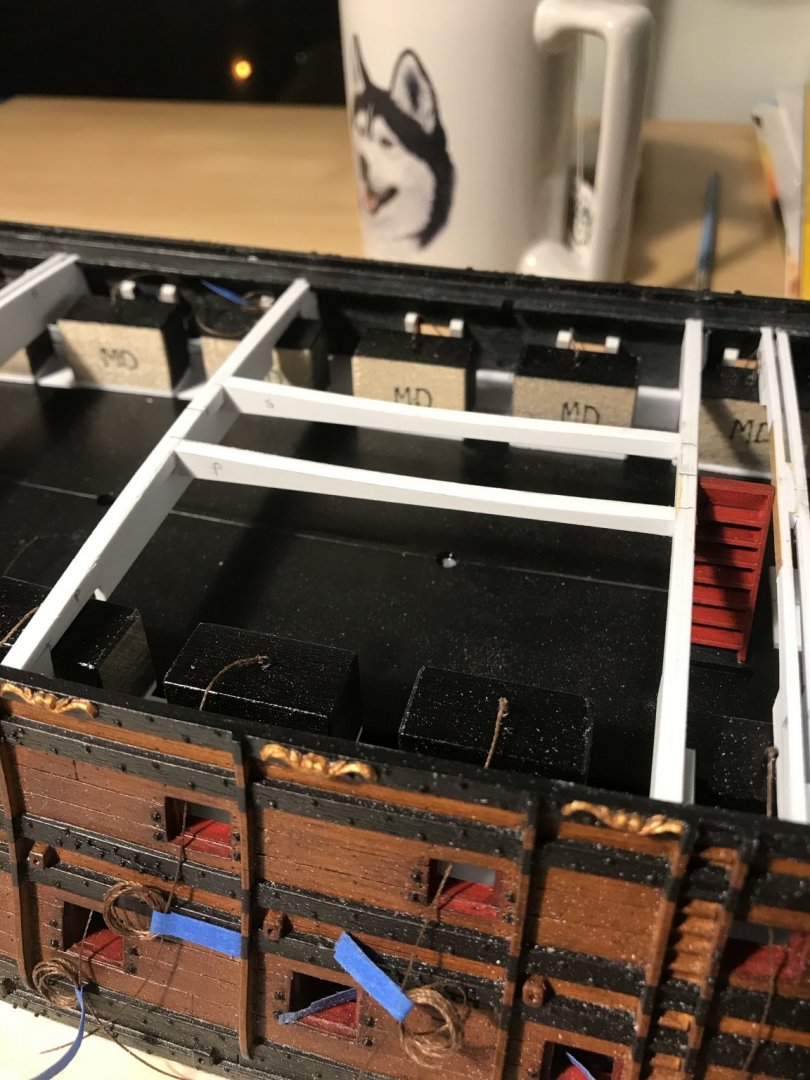-
Posts
3,308 -
Joined
-
Last visited
Content Type
Profiles
Forums
Gallery
Events
Everything posted by Hubac's Historian
-
That is an interesting detail. When you consider it, of course it makes sense for there to be a more substantial mass off timber to absorb the recoil. Even at this late stage, this modification would be possible. I am not certain about how that would affect the height of the barrels through the ports. Fortunately, I am pretty certain that I made one or two extra carriages that I can experiment on. Thank you for bringing that to my attention.
- 2,699 replies
-
- heller
- soleil royal
-
(and 9 more)
Tagged with:
-
Yes, Mr. Delecroix - those are strips of masking tape for later, when I mount the gun carriages. I have affixed styrene blocking to the undersides of the gun carriages, which will later be blacked out with flat paint: I thought I still had a pic of the blocking, but in any case, the glue block runs down the center of the carriage, between the axles. It was a calculated gamble, on my part, that the blackout paint will sufficiently hide the blocks. Even though structural integrity of the glue joint is not important, here, I prefer to make a more solid connection.
- 2,699 replies
-
- heller
- soleil royal
-
(and 9 more)
Tagged with:
-
Henry, I was probably using the wrong term, “block,” but this is what I had in mind for the tack fairleads: You can see the styrene shim, at the base, which was necessary in order to get a close scribe to the stem and plinth base. I added the through-bolting of the cutwater, which are actually two pieces - a diamond shaped washer and a tiny domed projection of styrene rod, on top: I have a tight scribe of the trailboard blank to the cutwater and stem. I won’t be able to scribe it to the upper head knee until after the cutwater is fixed in place: Once I have an exact size for the blank, I’ll re-draw the trailboard filigree. Ideally, the fleur-de-lis should align with the head timber supports. Realistically, though, this may need to be an area of compromise. I would rather have a good looking trailboard layout, than one that seems cramped to fit within and around the parameters of the gammoning. I have not decided yet, Dan, whether I will fill and move the gammoning holes. I was at my buddy’s house this weekend, and so I took a few head shots of my first Soleil Royal, as a reminder of the stock spacing of the whole assembly: Ideally, one of the fleurs should be centered between the gammoning. Because my headrails are now a good 1/8” short of where they need to land behind the figurehead, I do not think that I will be able to use them. I will try to heat-stretch them, because I have an extra set, but I am not optimistic about that outcome. It’s just a super complicated area. Once I can work out a trailboard layout that accommodates the current arrangement of the gammoning, I can begin patterning new headrails in cardboard, with headrail timbers that are interspersed around the gammoning. If no good layouts are possible with the gammoning where it is, then I will have to move the gammoning. EJ, I’ve been thinking about your comments on color, and I am inclined to agree. Then, it dawned on me that the color gouache Vary portrait has what I think can be taken as a literal guide for this sort of period stylized/naturalistic coloring. All of the cues are in the border of the portrait: There is also this coloration of the Berain drawing of L’Agreable’s stern, which I think is a useful guide to colors: So, what I will do on the starboard half of my spare figurehead is to darken the grey wash that I first applied to the horse, but I will do it in a graduated scale that gets darker as you approach the tail. Then I will apply the same translucent green wash that I use to simulate ver-de-gris on the guns. This, too, will be applied from light to dark. I will basecoat the Pixie’s face, arms and legs with random tan. A very light walnut ink wash will pick out some of the facial detail, while modulating the skin tone. Finally, I have a translucent red wash that, if applied very lightly, should round out the skin tone. I’ll finish by picking out the same details in gold. I have cleaned to the outline of the amortisement crowns, and they are now ready to carve: And so, we’ll see what all of that looks like. Thank you for your likes, your comments and for looking in.
- 2,699 replies
-
- heller
- soleil royal
-
(and 9 more)
Tagged with:
-
This isn’t my best paint work, and I haven’t completed the starboard side gold work, but I am looking for some feedback on this approach to the figurehead. Does this seem 17th C. French to you guys, or something else?
- 2,699 replies
-
- heller
- soleil royal
-
(and 9 more)
Tagged with:
-
Just really beautiful, clean work, Mike!
- 607 replies
-
- winchelsea
- Syren Ship Model Company
-
(and 1 more)
Tagged with:
-
Yes, because these head timbers correspond with the headrail supports. Here are a few pictures of my favorite model of L’Ambiteaux. The bow shot illustrates all of these design considerations quite nicely:
- 2,699 replies
-
- heller
- soleil royal
-
(and 9 more)
Tagged with:
-
Dan, you are definitely correct that the positioning of the headrails has the most influence concerning the placement of the gammoning. I will have to make a decision sooner, rather than later as to whether I will make the headrails from scratch. Yet another issue of the Heller kit is that there is very little clearance for the headrail supports that the kit (and Tanneron’s model, for that matter) has omitted. Making the headrails from scratch might give me a few extra millimeters clearance, while also solving the problem of the forward headrail scroll rising above the bowsprit mast, which it should not.
- 2,699 replies
-
- heller
- soleil royal
-
(and 9 more)
Tagged with:
-
With the ears of the knees temporarily removed, I can now get a better idea of the relationship between the upper stem knee and the cutwater. The upper stem knee mates nicely with the angle of the kit’s stock sprit mast, and the cutwater requires some scribing to fit up nicely to the stem: If I place an ear back into position, I can see that it won’t take much scribing and filling to blend the whole assembly back together seamlessly: However, before I can make any final adjustments to fit, I really need to see what the trailboard space looks like along it’s entire length. To see that, requires fitting and attaching the figurehead. For a stock assembly of this kit, one always ends up with a tapered opening where the trailboard should be. I can scribe the cutwater so that this opening is parallel, but doing so also has an impact on the kit’s stock headrails, which, like the figurehead, are really nice. I am hoping to be able to use them in the build despite the increased width of the hull, which has a shortening effect on the headrails. More on that later. Before attaching the figurehead to the cutwater, I wanted to make some modifications to the cutwater. First, I wanted to file-in a slight, and graduated taper to its leading edge, as marked out here: You can see that the plastic is plenty thick enough to reduce it by half it’s thickness, at the base of the cutwater. In the end, the difference is subtle, but noticeable if you are looking for it. The other big problem with Heller’s representation of this massive and fundamental structure is that the timbering, with its butt joints and sandwich laminations bears zero resemblance to the interlocking structure of a ship’s cutwater: Above, the laminations cross the gammoning holes in ways that no shipwright would ever allow. On better representations of this cutwater structure, the gammoning holes are often angled to follow the run of the timbering. For inspiration, I looked to the St. Philippe monograph: This is good because the timbering is not overly complicated, and it doesn’t interfere with the gammoning; never-mind, for a moment, that the SP gammoning is drawn below the water line - that is its own issue. The main thing that I don’t like about this SP timber layout is that the joinery is all straight lines. In reality, these timbers would have been carefully selected for natural grain that pretty closely follows the shape of the stem, thus dramatically increasing the strength of the structure. Strength is critically important when you consider the massive weight of structure that the cutwater is supporting (figurehead, headrails, et al), as well as the dynamic ocean forces playing upon it at all times. So, with that in mind, I looked to what Marc Yeu chose to do for his SR: (photo, courtesy of Marc Yeu) Note that the trailboard opening is parallel. I believe that Marc adopted Frolich’s timbering for L’Ambiteaux. To me, this is a much more natural looking structure, so I chose to adapt it to the Heller stem. I considered filling the gammoning holes and re-orienting them, but decided against it, after I had arrived at a layout with minimal, and dare I say plausible, interference: Above, after much careful fitting, the figurehead is secured, and I have filled the hole for the fore-course tack lines. Instead, I will be making a block for these that attaches to the leading edge of the stem. I will probably also represent the through-bolting of the stem, on its leading edge. It’s a simple thing to do and adds a nice touch of realism to the model. So, as I consider the coloration of the head, the figurehead offers me an opportunity to experiment with an idea I have about coloration of all the really large statuary - most especially, the four continental figures of the stern. Just about everyone who builds this model paints all of these figures solid gold. It is hard to argue with that choice, as that is how Peter Vary represents her in his coloration of the Berain design: The issue I have with this is that I find that much gold to be overwhelming, and the effect it has is to diminish the impact and beauty of the ornamental design; everything seems to get lost in a sea of gold! I have an extra figurehead to experiment with. I would like to see what the horse would look like painted white, with a light grey wash to give it some depth and shading. I would pick out the main, the reins, the riding pixies, the acanthus leaves along the horse’s belly, and the horse’s tail in gold. meanwhile, the moulding of the knees would be painted yellow ocher, instead of gold, as will be the fretwork of the trailboard; only the fleurs and bellflowers of the trailboard will be picked out in gold. If I really like this, I will apply it to all similar figures. Although things may have been different in 1670 (Hyatt’s description of the RL being EXHIBIT A), by 1688 - in the midst of a horrendously expensive re-build of SR - it only seems sensible that the ship would NOT be completely covered in gold leaf and lapis-based ultra-marine. These are stylized choices I would be making, but I think they are appropriately representative of the period. The deck gratings are painted now, and I will soon be gluing-in the main deck: To get a sense for how effective the walnut ink is, take a look at the contrast, where I haven’t yet applied it: In the first picture, above, I have modulated the effect a bit, to tone it down - super easy with a dampened brush. It’s probably still a bit over done, but I like the grubbiness of the effect. Thank you for the likes and looking in!
- 2,699 replies
-
- heller
- soleil royal
-
(and 9 more)
Tagged with:
-
While I wait for my deck to cure, I thought it would be a good time to start constructing the head. Now, I knew that I would have to adjust the knees of the head to accommodate the increased width, at the bow, but I naively believed that it would be a simple matter of scribing them to fit. Well, that’s not going to work out so neatly, after all: I think the only way around this is to cut off the knee extension pieces, scribe the loose ends to fit, and the rejoin the cutwater with a styrene filler piece that can be shaped and moulded to match. It seems iffy, but I think I can pull it off. Assuming this works out, and I can use these parts, I would like to introduce a taper to the leading surface of the cutwater. The plastic is thick enough that I can represent the taper without compromising the part. Since doing so will eliminate most of the timber structure and graining, I will go-ahead and re-engrave a more likely timber structure than what Heller has provided for. Both of the figureheads I have are somewhat warped, but one is a better fit than the other; its irregularities can be finessed and minimized. Today, I finished the Pixies. I wish that I were better at carving faces, but this was the best that I can do, for the time being: Next, I’ll make the crown ornaments that the Pixies are supporting. By the time those are done, I should be ready to pattern and carve the trailboard that fills the space between the head knees.
- 2,699 replies
-
- heller
- soleil royal
-
(and 9 more)
Tagged with:
-
No need to go to any trouble, ClipperFan. Your description of the poster sent my mind to riffin’ on those outrageous and spectacular old vans. In any case, your talents are plainly evident to me. I’m glad you are enjoying this project!
- 2,699 replies
-
- heller
- soleil royal
-
(and 9 more)
Tagged with:
-
ClipperFan, indeed it will be! Your Norse mythology poster sounds like its rightful place would be airbrushed along the side of this sweet honey: An actual 1975 Dodge (MOPAR MADNESS!!) panel van. I love 70’s Dodge, and obviously, I will exploit any opportunity to incorporate it. Seriously, though - the ground color of this particular Dodge seems perfect for the 8-legged horse you describe. Just the idea of it reminds me of Spinal Tap; “These amps go to ELEVEN...” I know it’s a reach, but do you still have the poster?
- 2,699 replies
-
- heller
- soleil royal
-
(and 9 more)
Tagged with:
-
It is fascinating to me which aspects of this whole discussion of SR - my build log - take off. I am enjoying the debate! Clipper Fan, while I have been pretty emphatic, at times, about various aspects of my interpretation, I have discovered over time that many of my early assumptions were just wrong, and it is people like yourself, who have helped me to see that. Discussion and debate is the primary goal of maintaining this build log, as filling-in the missing details is often vague. Now that you have brought it to my attention, I share your fascination for McKay’s secrecy. In that time, though, I suppose maintaining competitive advantage was what the windjammers were all about. If life ever returns to semi-normal, I’ll have to make a visit to the India House to see that figurehead. It is a lovely example of the art form. For a good stretch of time, I lived only blocks away from there. So, it’s official - we are collaborators! Specific projects and renumeration, TBD. It is a while off, though. Whenever it is that I finish this project, I will immerse myself in whatever the best-suited drawing software there is for creating a monograph-style set of plans. I’m hoping that these things will have become super user-friendly, by then. Once I can navigate something like that, I can begin developing a plausible hull form. Once I’ve made a simple foam maquette to test the volumes of my hull, I can begin drawing all of the structure, in detail. Once we have a structure to reference, we can begin to flesh-out the ornamental program. Much of the discussion of the book is already written, long-form, in the pages of this log; of course, my arguments and observations will need to be better substantiated by primary sources. Going to France on a research junket will be hell, but I think I’ll be able to soothe myself with their food and wine😉, and their general joie de vivre. So, it’s all a ways off, but this is my plan, anyway. Last night, I distress washed my main deck. The Windsor and Newton grey does a fabulous job of getting into all of the engraving, while silvering the random tan, acrylic base-coat. Then, the Van Dyke Brown works its magic and the whole thing looks appropriately weathered. I’ll give the oil a few days to cure before I paint the hatches and coamings red ocher. As I have done, elsewhere, I’ll use the walnut ink to wash the red. Now, speaking of missing details, I am trying to work out the details of the stove. Unfortunately, the St. Philippe monograph isn’t much use for me, in this area, because the main hearth and bread oven are two separate structures that are placed between the guns, on the middle deck; one to port, and one to starboard. I want to centralize these two things on the main deck, beneath the forecastle deck, with one chimney. While I have a good idea what the timber cladding and iron strapping would look like on the outside of the brickwork, I can’t find any reliable references to what the brickwork should be for a combined cauldron stove/bread oven. Would they even have been combined? For all practical purposes, very little beyond the timber clad bulkhead will even be visible, but I would like to know what should be, for SR 1670. Your likes comments and input are all greatly appreciated.
- 2,699 replies
-
- heller
- soleil royal
-
(and 9 more)
Tagged with:
-
As a side note, one of the vexing incongruities of the bow and quarter drawings is that the bellflower garland does not run continuously from stem to stern, all on one level. In the quarter drawing, the Pixies are holding the garland, but it terminates, at the quarter deck level, into the roof of the amortisment. The bow Pixie has a garland in each hand, and the drawing suggests that swags of bellflower garland will run continuously, the whole length of the ship, between the round main deck ports. From the bow Pixie’s forward hand, the garland even runs through the middle headrail to the hippocampus Pixie. Yet, the garland is conspicuously absent in-between the round ports of the quarter drawing. As I have noted elsewhere, though, Berain’s drawings often have strange incongruities from one view to the next. Much as I imagine the original sculptors had to do, modeling this ship is an exercise in interpretation.
- 2,699 replies
-
- heller
- soleil royal
-
(and 9 more)
Tagged with:
-
It is very easy to become myopic on a project like this, and so it is refreshing to see something new through another person’s eyes. ClipperFan, your interpretation of the Pixie/Mermaid figures is really interesting to me for a number of reasons. Mermaids challenge one to wonder why they’d be included in the ornamental program, in the first place. My best and honest guess was that they were sort of visual companions to the lonely, conscripted crew, whom would be obligated to spend long periods of time away from the actual women in their lives. In the folklore of the sea, though, Syrens always seem to lead hapless sailors to their untimely end. On the other hand, Pixies offer an alternative rationale as figurative guardians of the ship. It is interesting to note that Berain’s drawing of the head includes a third Pixie-like figure, just aft of the headrails. She has fully formed human legs: Another Pixie rides the hippocampus figurehead. And so, from stem to stern, their magic spell would shield the ship and her crew from undue harm. With specific regard to the stern figures, though, I just really like the playfulness of your idea, where dolphins have swallowed the Pixie’s lower legs, thus adapting them to their aquatic task. With this interpretation, there is also a nice interplay with the four dolphin figures on the main deck level of the amortisement. Your idea speaks to the duality of these ships that I have always found so fascinating, and that is that these truly terrifying machines of war were ornamented so impressively, and with the greatest artistic sensitivity to their times. I am also really impressed, ClipperFan, with the apparent ease and naturalness of your own quick sketch. Drawing anything is something that I really have to labor over, in order to capture the essence of the thing. You appear to have a real talent for it! Perhaps, down the road, I could hire you to help me visualize, in 3D, the ornamental program of SR 1670 - my so-called Gilded Ghost. While even now, I can see pretty clearly in my mind’s eye, what the basic shape and parameters of that project need to be - to capture a sense of the ornamental style of the early 1670s is a tall order! The project essentially amounts to combining the substance of LeBrun’s conception of the allegory, in the artistic style of Puget, and supported by appropriate ornamental embellishments of the time. I am also wondering whether you are an L.A. Clippers fan, in addition to being a fan of clipper ships.
- 2,699 replies
-
- heller
- soleil royal
-
(and 9 more)
Tagged with:
-
All very impressive, George! I’ll be happy to follow along on this one, as well.
- 22 replies
-
- royal louis
- heller
-
(and 1 more)
Tagged with:
-
Just a quick update: In all likelihood, I will cut away the smaller, inside wings because they interfere with my aft octagonal ports. However, until the amortisement is made and I can see the actual relationships of all these parts, I wanted to keep all options open. Tomorrow I will start the heads, but my own head is growing weary and my neck is getting sore, after sitting hunched over these gals all day. I tend to start making mistakes when I push through. A few of those mistakes, I’ll be filling-in with BONDO, this evening, as I prepare the main deck for painting and priming; some of my nail impressions were poorly placed, and/or ill-conceived. I’m excited to get back to a little painting, though. In addition to the Windsor and Newton Van Dyke Brown, I will experiment with a lightish grey Windsor and Newton oil shade, that will be applied and wiped streakily before a blanket application of the brown. The deck is coarsely sanded, so it should pick up these colors nicely.
- 2,699 replies
-
- heller
- soleil royal
-
(and 9 more)
Tagged with:
-
If she does, Dan, I’ll vouch for your character. Wouldn’t it be kind of hilarious, if Daryl Hannah were doing a Google search of her name, and landed on this page? Daryl, if you’re out there reading this - we still love you!
- 2,699 replies
-
- heller
- soleil royal
-
(and 9 more)
Tagged with:
-
Thank you very much, guys, for your kind compliments. It isn’t so much that Mermaids have legs above the knee, but that Berain was maybe suggesting musculature. Here is what Berain drew, originally: Now, if you compare that with this Nat Geo photo of Daryl Hannah in the wild, I think we can agree that Berain was on to something:
- 2,699 replies
-
- heller
- soleil royal
-
(and 9 more)
Tagged with:
-
Thank you very much, Shipman! The figures are carved from styrene, but don’t be too amazed; carving styrene is analogous to carving soap, for beginners. Carving these figures in wood would be a whole ‘nother story! Alternating grain makes carving wood much more finicky.
- 2,699 replies
-
- heller
- soleil royal
-
(and 9 more)
Tagged with:
-
Steady progress: One of the things that anatomy forces you to learn are ways in which to introduce the soft hollows of a body, with whatever tool can get into tight spaces. In the area of the belly and hips, I don’t have a gouge that’s small enough to get in, close to the side of the body, without the arm getting in the way. What I use is the hooked knife to scrape hollows on a bias, according to the same principle of cutting a cove moulding on a table saw, by running a fence at an angle to the blade. The scraping motion, at an angle, gently introduces a hollow that, in this case, defines a fleshy love handle. Each scrape removes just a little material at a time, and eventually you arrive at where you want to be. One other thing I’d like to mention is the undercutting of the upper thigh. I could simply define the lap line, where one thigh rests against the other. This would look okay. However, the pose of the figure suggests that the outer thigh overhangs the other leg. What I like to do here, to suggest this, is that after I have first defined that meeting line - the line that delineates the shape and proportion of each thigh - I come back with sharply angled scrapes that undercut the outer thigh. I use the sharply beveled tip of the EXACTO to do this. The accentuated shadow line creates a false sense of depth in what is a very shallow carving. While I wait for my #80 drill bits to arrive, I have made and fit the fore and aft sections of the main deck. Unlike the middle deck, where I had to make mast plates to fix the plumb and rake of each mast - I now had a reliable reference to measure the exact centerline of the fore and mizzen masts; I could measure directly from the fore and aft edges of the main deck center section to the center of each mast. The masts are all in alignment, now, and the slight bow of the mizzen will eventually be corrected by the stays and shrouds. I have also decided to re-enforce the main deck hatch openings with carlings that are scribed to the longitudinal curvature of the deck. The styrene I’m using for the decks is a bit thinner than what the stock kit provides, and is not as rigid. It is my pathology to overbuild the whole thing, so, here you go: I enjoy the exercise of scribing and fitting these curved parts because it is good practice for when I eventually transition to wooden builds. Thank you for looking in. More to follow...
- 2,699 replies
-
- heller
- soleil royal
-
(and 9 more)
Tagged with:
-
As always, Frank, this is incredible work. I really love what you are doing, here.
- 510 replies
-
- reale de france
- corel
-
(and 1 more)
Tagged with:
About us
Modelshipworld - Advancing Ship Modeling through Research
SSL Secured
Your security is important for us so this Website is SSL-Secured
NRG Mailing Address
Nautical Research Guild
237 South Lincoln Street
Westmont IL, 60559-1917
Model Ship World ® and the MSW logo are Registered Trademarks, and belong to the Nautical Research Guild (United States Patent and Trademark Office: No. 6,929,264 & No. 6,929,274, registered Dec. 20, 2022)
Helpful Links
About the NRG
If you enjoy building ship models that are historically accurate as well as beautiful, then The Nautical Research Guild (NRG) is just right for you.
The Guild is a non-profit educational organization whose mission is to “Advance Ship Modeling Through Research”. We provide support to our members in their efforts to raise the quality of their model ships.
The Nautical Research Guild has published our world-renowned quarterly magazine, The Nautical Research Journal, since 1955. The pages of the Journal are full of articles by accomplished ship modelers who show you how they create those exquisite details on their models, and by maritime historians who show you the correct details to build. The Journal is available in both print and digital editions. Go to the NRG web site (www.thenrg.org) to download a complimentary digital copy of the Journal. The NRG also publishes plan sets, books and compilations of back issues of the Journal and the former Ships in Scale and Model Ship Builder magazines.




